24 Hours in Stari Grad: For Those Seeking a More Laid-Back Experience
May 13, 2022 – Come with me as I explore different facets of this rustic jewel in this 2-part series, as we spend 24 hours in Stari Grad, one of Hvar's most popular towns.
With an average of over 2715 hours of sunlight a year, the Croatian island of Hvar offers plenty of fun in the sun. From its series of natural wonders including fresh springs, fruit orchards, lavender fields, and award-winning vineyards, to the allure of its world-renowned nightlife, Hvar is guaranteed surpass even the highest of expectations.
A brief history of Hvar
Did you know that the history of Hvar dates back over 5000 years? The earliest inhabitants of Hvar Island were the Neolithic people in 3500 B.C. During the 4th century, Hvar was initially colonized by Greeks, but following the Roman victory in the Second Illyrian War, the island became a part of the Roman Republic.
The island joined the Kingdom of Croatia in the 11th century but eventually fell under Byzantine rule, before becoming a part of the Kingdom of Croatia and Hungary in the 12th century. In 1409, the Venetian Republic regained the right to rule Hvar for over 5 centuries, before it was annexed by the Habsburg monarchy in 1979.
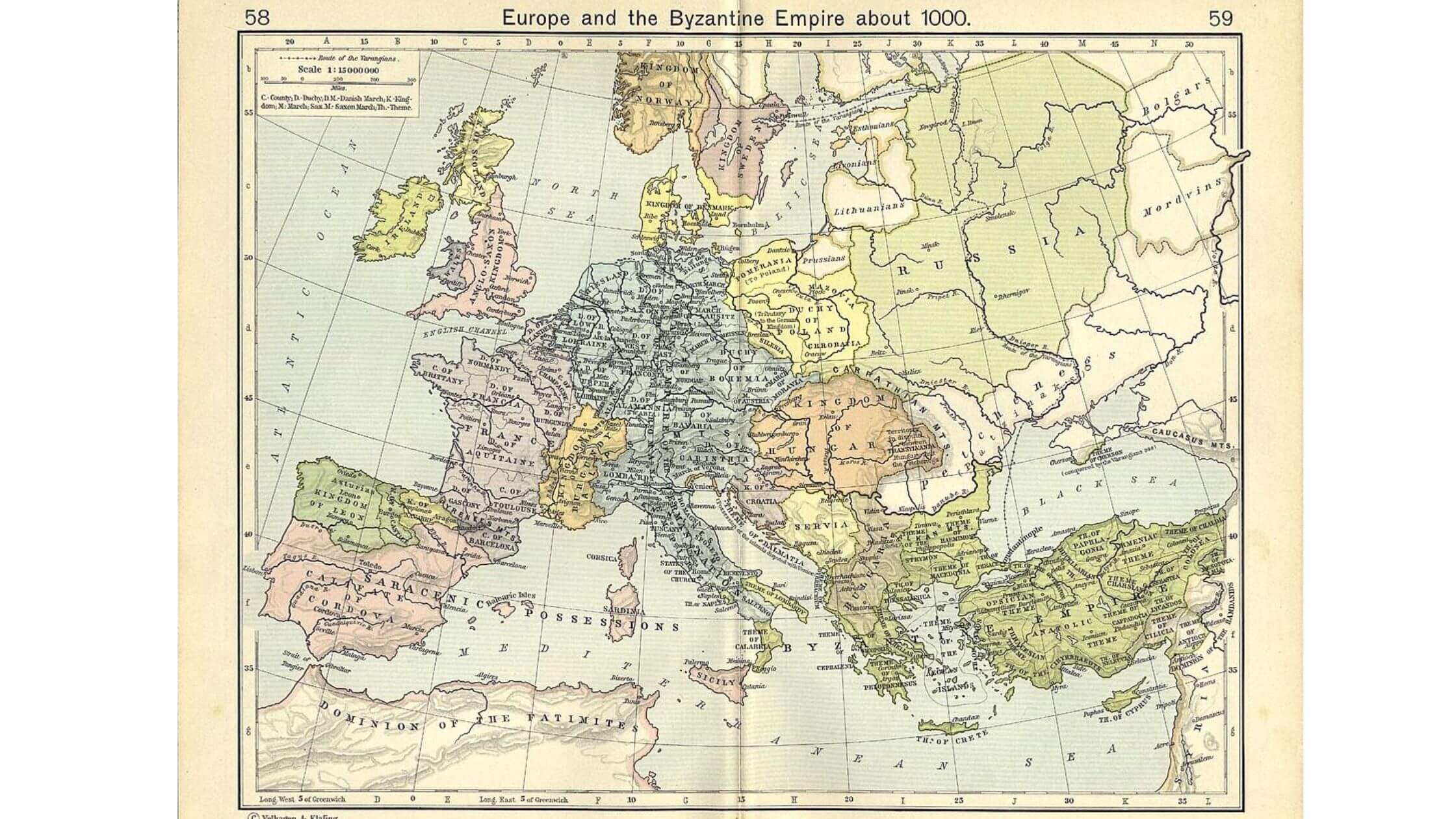
A map of Europe in 1,000 A.D. with the Kingdom of Croatia. (Image: Wikimedia Commons)
Over the next decades, Hvar changed hands a few more times. The French Empire seized the island in 1806 during the Napoleonic wars, before it fell under British rule in 1812. In 1815, Hvar was controlled by Austrians, before it was occupied by the Italian army from 1918 to 1912 under the Kingdom of Yugoslavia. Finally, after the end of WW2 in 1945, it became a part of the People's Republic of Croatia.
Right, that was essentially Hvar’s 5,000-year history, brutally squeezed into 3 short paragraphs, but since we only have 24 hours, let’s begin a full day of activities in Stari Grad. Not only does this town attract a more relaxed clientele, as you’ll see, it’s also much cheaper than neighboring Hvar town!
8.30 a.m - 10.30 a.m.
The majority of Hvar visitors begin their trip at the Split ferry terminal. In Summer, the state-owned Jadrolinija ferries or catamarans run regular service lines to 3 different ports on Hvar: Split-Hvar, Split-Jelsa, and Split-Stari Grad.
From Split-Hvar, a catamaran runs almost every other hour, with the earliest ferry leaving Split at 8.30 a.m. Prices for the catamaran are the same for both children and adults, at 110 kuna (€14.50) one way. The Split-Jelsa catamaran first detours to Bol on Brač island (so the line really is Split-Bol-Jelsa), and only runs once a day, departing Split at 4.30 p.m. Tickets are 63 kunas (€8.40) per adult and 30 kunas (€4.00) for children between 3-12 for a single trip. Do note that the catamarans are foot/pet traffic only!
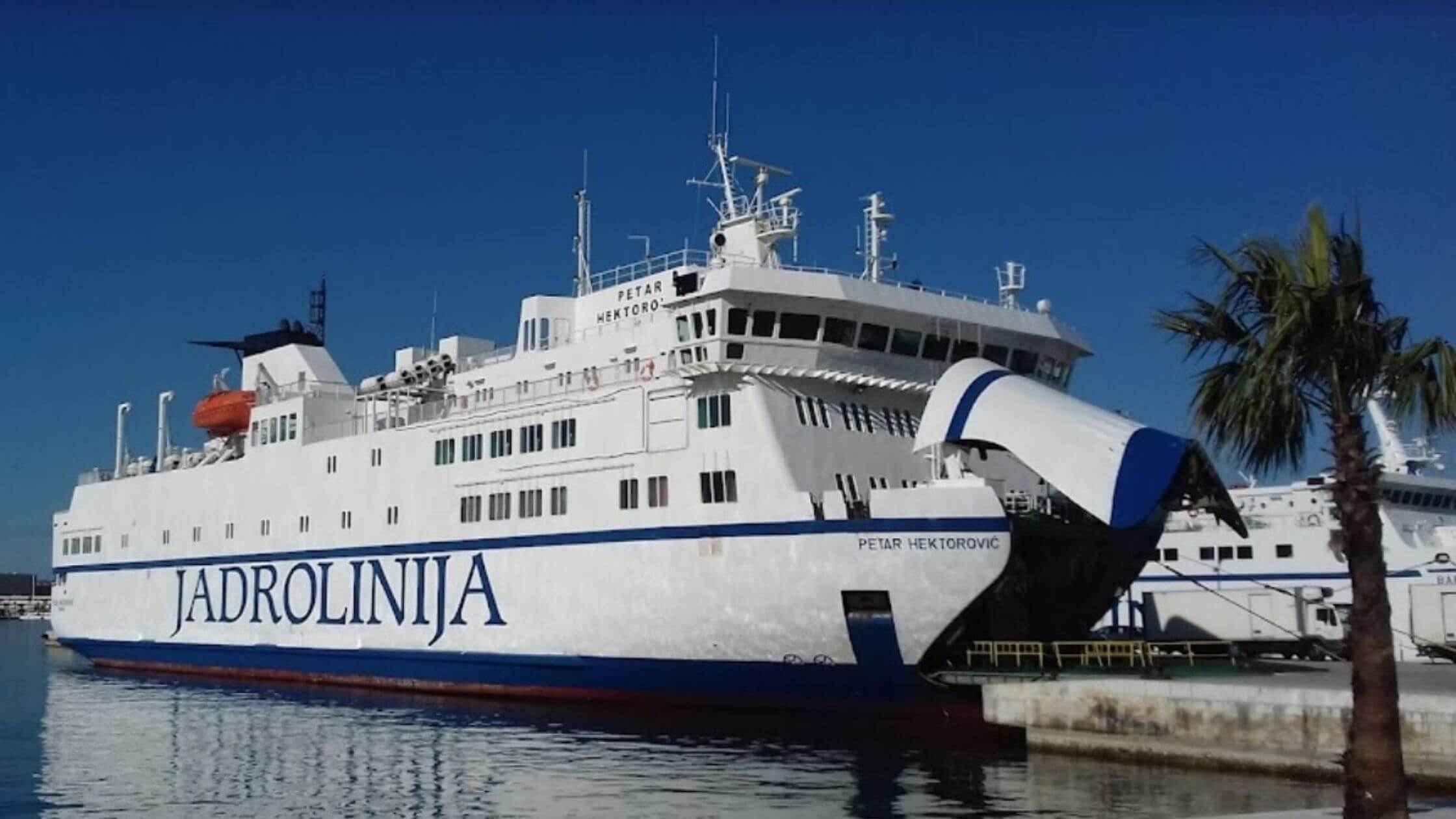
(Image: Stipo Rajic/Screenshot)
Finally, we have the ferry line that will kick start our trip from Split-Stari Grad. Leaving Split as early as 1.30 a.m., the Split-Stari Grad ferry service runs 7 times a day at the peak of the season. Since it’s a ferry, you’ll be able to drive your vehicle on board so if you’ve rented a car in Split and intend to drive it over Hvar Island, this will be your port of call as well. Prices start at 55 kunas (€7.40) for an adult and 27.50 kunas (€3.70) for children 3-12, for a one-way journey.
10.30 a.m. - 11.30 a.m.
A 2-hour ferry ride later and you’ve arrived in Stari Grad, Hvar Island. The first thing to do is to drop your bags off at your accommodation and make a beeline to Stari Grad’s palm-lined Riva.
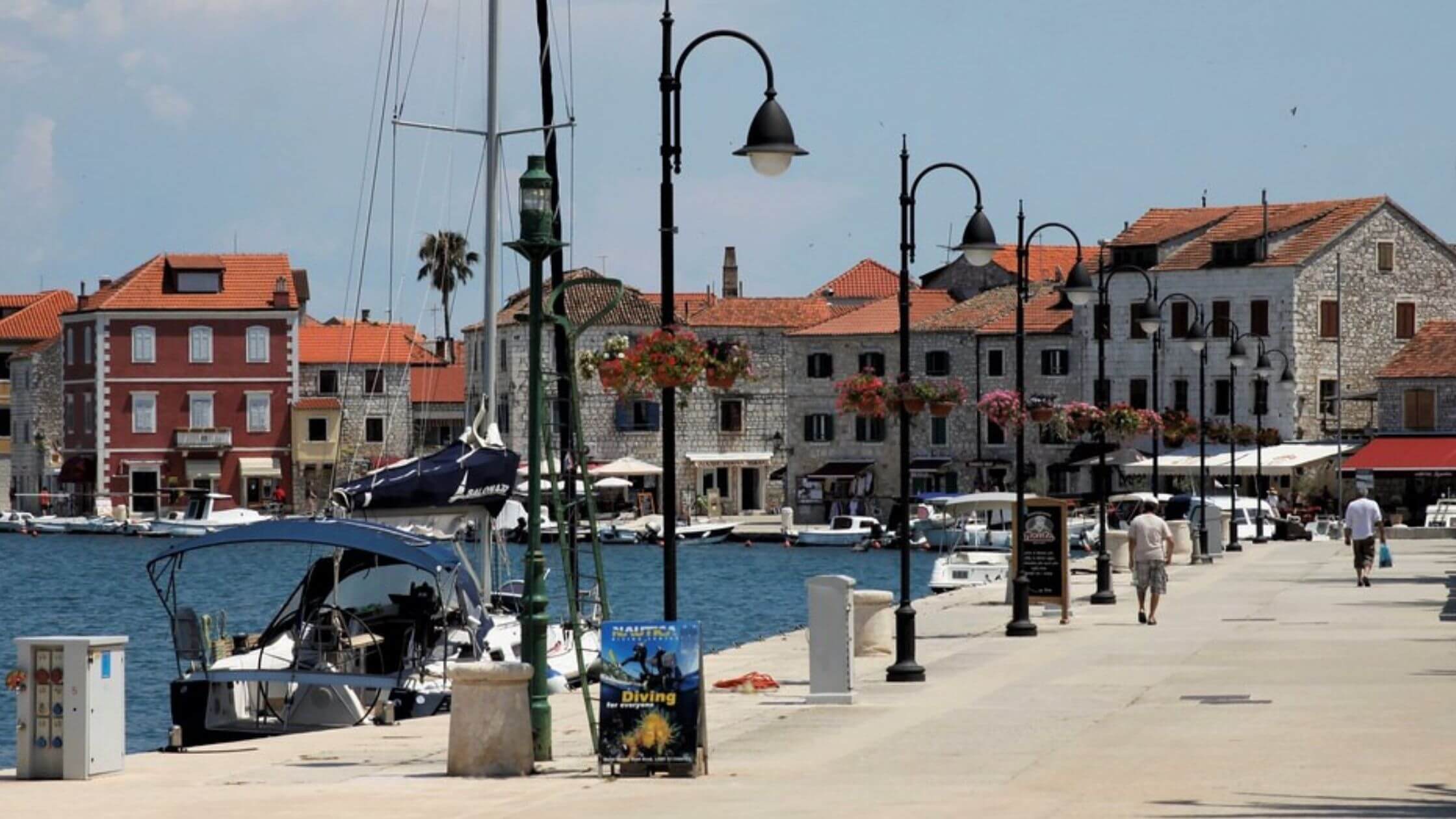
There's no better place to relax and let your mind wander. (Image: Pixabay)
Surrounded by Venetian Renaissance buildings, the Riva is the heartbeat of the city. Here, you’ll find everything you need including cafes, bars, restaurants, souvenir stands, boutiques, and grocery stores. It’s perfect for a spot of people watching while snacking on some Burek (Croatian flakey pastry filled with a combination of cheese, meat, and spinach) with your coffee or Aperol Spritz (I mean, you’re on vacation, and its noon somewhere, right?)
11.30 a.m. - 1.30 p.m.
With your energy levels renewed, time to do some exploring! For 20 kunas (€2.65), head on into Tvrdalj fortress, the summer residence of Croatian Poet Petar Hektorović (1487-1572). Cocooned in this oasis, Hektorović produced some of his finest poetic works on Hvar’s fishermen such as – Ribanje i ribarsko prigovaranje, 1568, eventually becoming a vital figure in Croatian literature during the Renaissance period.
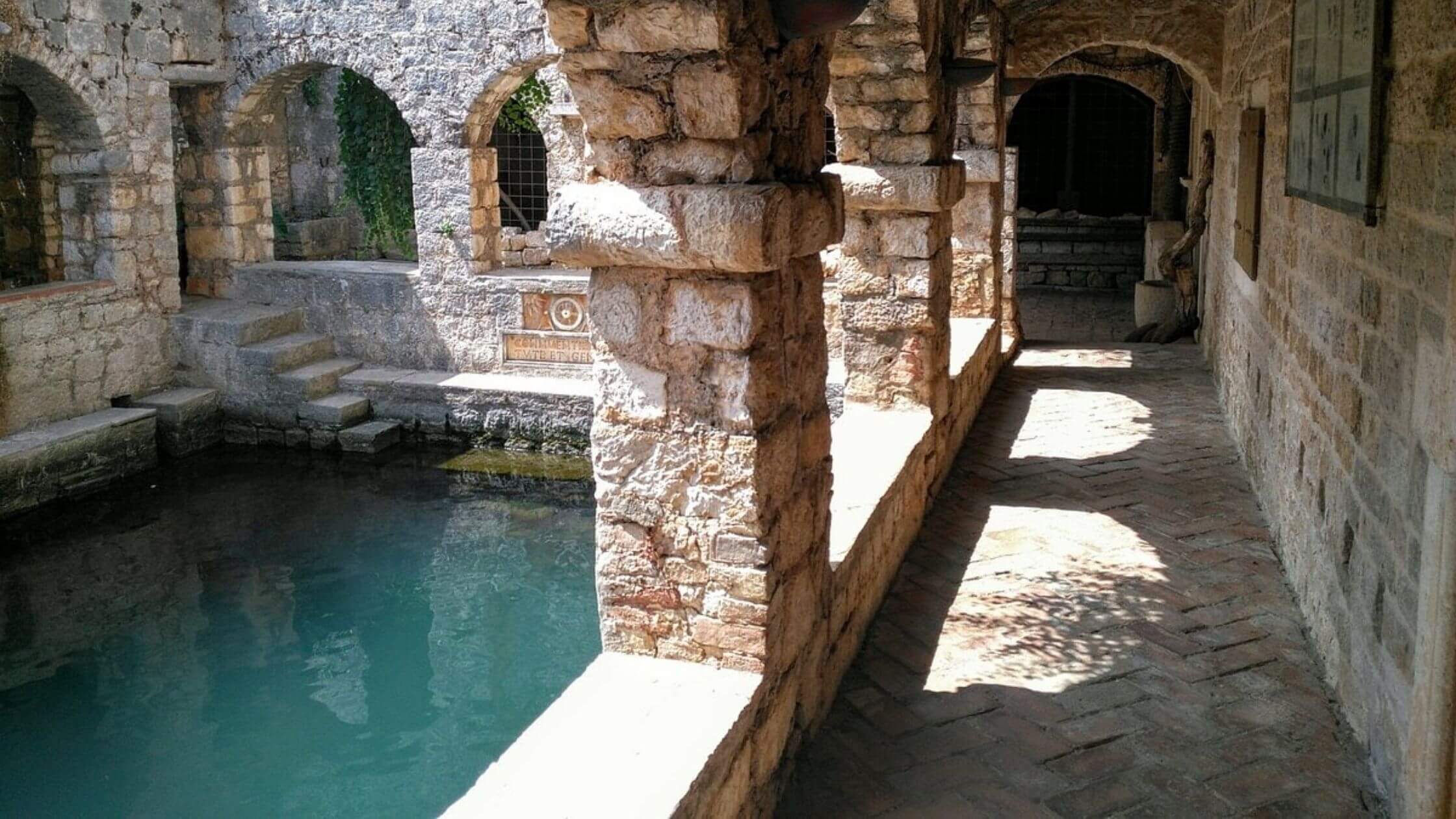
Step inside the calm of Tvrdalj fortress. (Image: Alain C.)
In the vicinity are also a series of churches such as the Church of St. Stephens, built-in 1605 on the same site of a previous cathedral that was destroyed in 1571 during a Turkish invasion. There is also the church of St. John which houses archaeological remains of the original building that dates to the 5th or 6th century, and the church of St. Petar Muenik and the Dominican monastery that was founded in 1482.

Church of St. Stephens. These churches contain many important artworks by famous Venetian artists which are still on display today. (Image: Rory321)
Make sure to make time for wandering around the backstreets of Stari Grad to admire the architecture and take the opportunity to stop by Škor Square for a series of highly-instagrammable pictures. If Mamma Mia had another prequel (or sequel?), this be an ideal setting with its curved archways, stone houses, shuttered windows, and quaint staircases.
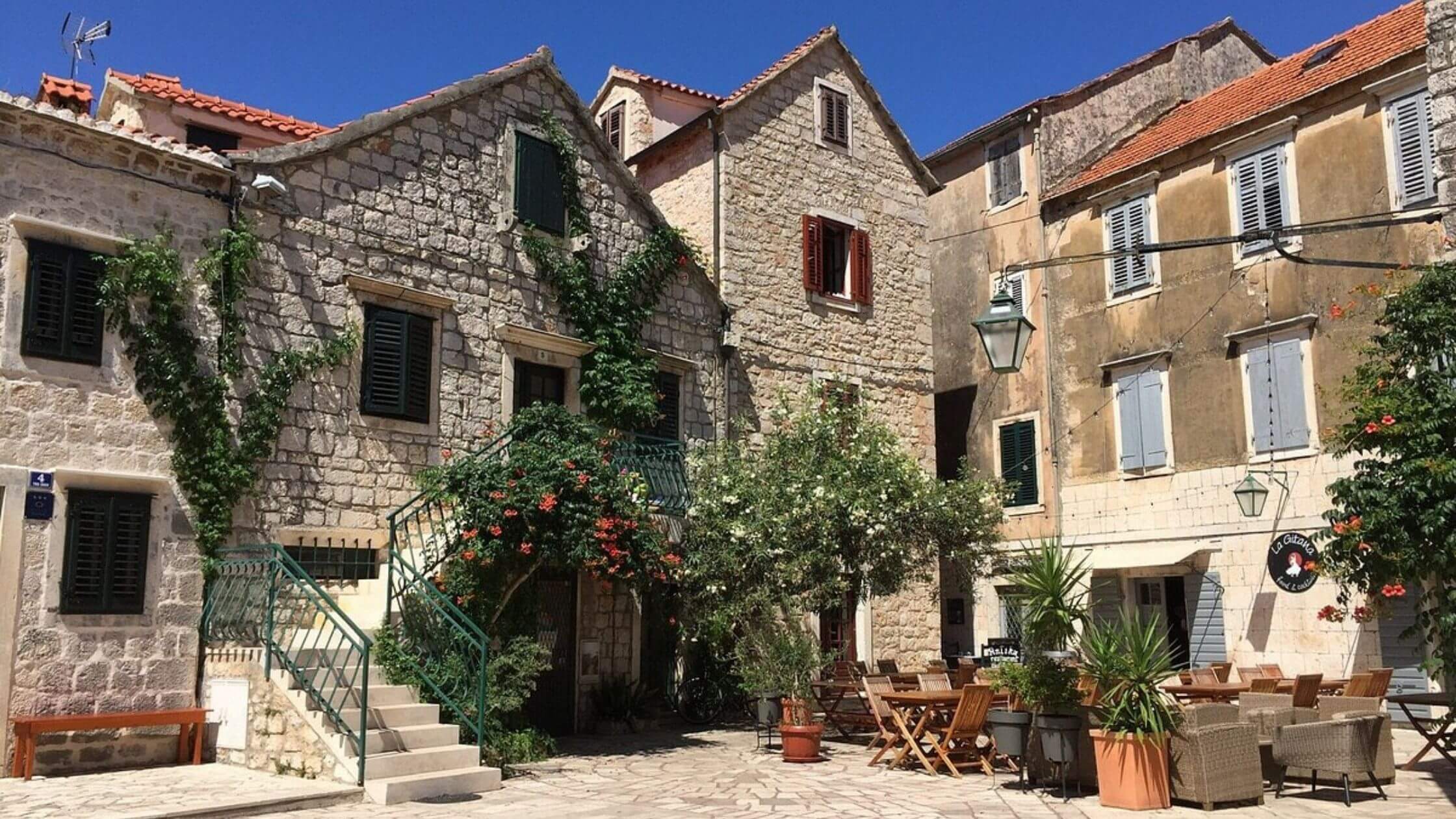
The word škor derives from the word škver, meaning shipyard in the Dalmatian dialect. (Image: Chrissieb94/Tripadvisor screenshot)
Also wander along Srinjo Kola (translated to: Middle Street), one of the busiest and largest streets on Hvar Island during the 1870s and 80s, when maritime trade in the region was at its peak. Once bustling with merchants and traders from all over Europe, Srinjo Kola today has more of a bohemian vibe, housing quaint cafes and traditional souvenir stores. Don’t forget to peek at the ancient Roman mosaic discovered during an excavation last year!
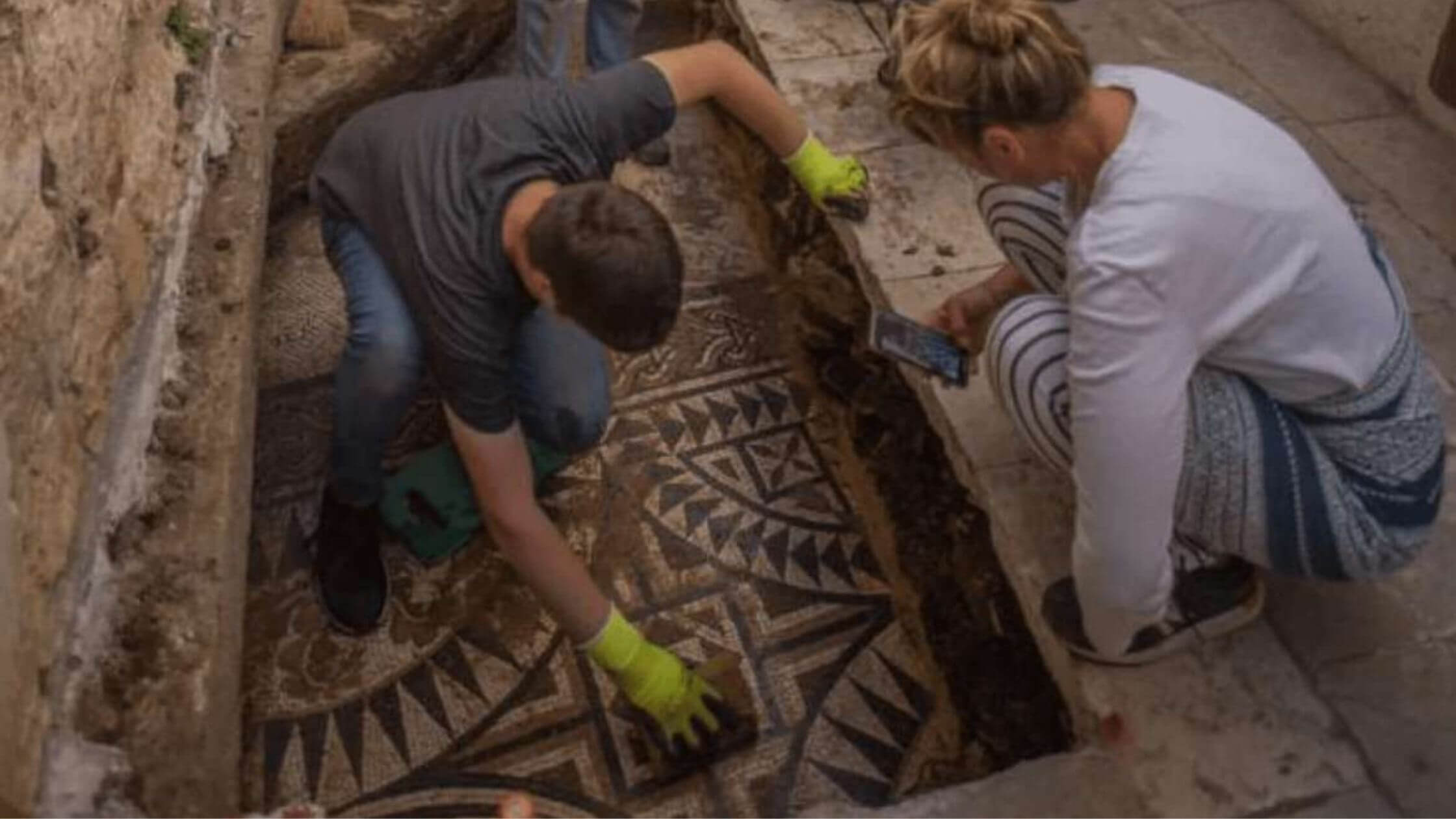
(Image: Vilma Matulic)
1.00 p.m. - 2.00 p.m.
Time for lunch! Before moving to Croatia, I had no clue that the pizzas here were outstanding. I guess it’s difficult when you’re overshadowed by neighboring Italy who arguably invented the dish. But what’s not to like about a wood-fired, slightly charred thin crust, tangy tomato base with innovative toppings? And the icing on the cake, it's a quick, cheap, and filling meal on its own.
So, you know where this lunch recommendation is going. Head on over to Mola Podloža and treat yourself to a Pharos pizza - think breakfast in pizza form, complete with bacon and runny egg. This, paired with an ice-cold beer makes a perfect lunch in my books, all for around 100 kuna (€13).

Dalmatian prosciutto makes a fantastic pizza topping. (Image: Pixabay)
2.00 p.m. - 5.00 p.m.
As much as you’d want to take a nap right now, I’d suggest a visit to the Stari Grad Plains. Stari Grad is home to one of the oldest cultivated plains in the world which dates back over 2,400 years when the Greeks colonized Hvar Island in the 4th century.
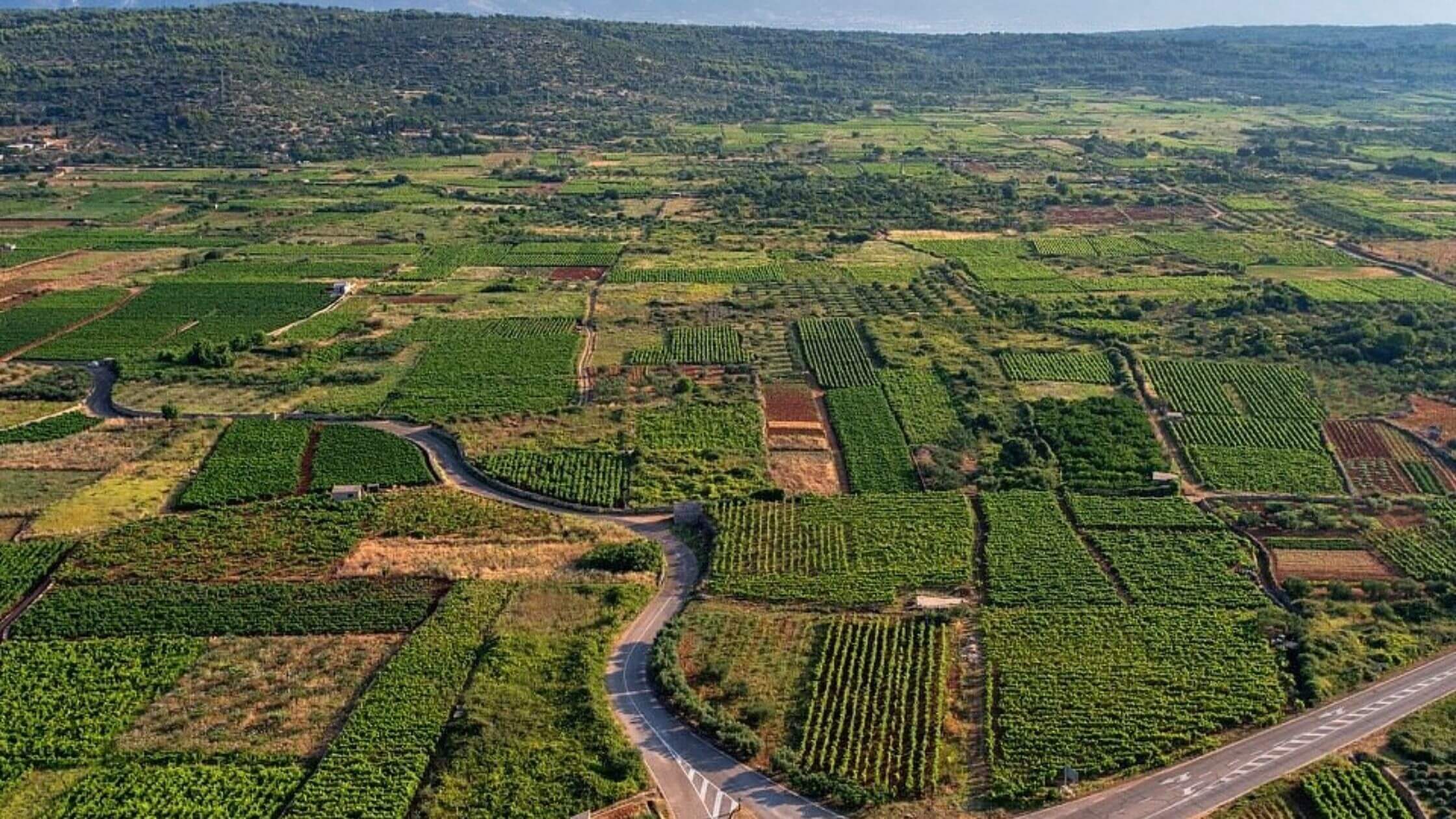
The same crops from centuries ago still grow today. (Image: Visit Hvar tourist board/Facebook screenshot)
For over 2 millennia, locals have maintained the plans in almost their original form, so much so that in 2008, the plains were declared a UNESCO world heritage site for being one of the last remaining ancient Greek agricultural plains in the Mediterranean. Today, they grow the same crops as the 4th century Grecians – olives and grapes, producing some of the best olive oil and wine in the world.
While you can opt to walk around the plains, I’d prefer to rent a bike at one of the many kiosks clustered along the Riva and explore at your own pace. Stop and check out the ancient ruins along the way, sample some olive oil, or enjoy a glass of local wine at one of the restaurants in the area (e.g., Hora, Rugonj, Dionis). The best time to visit is from end-May to mid-July since it coincides with the Lavender Festival, and you’ll be able to avoid the intense heat of high Summer.
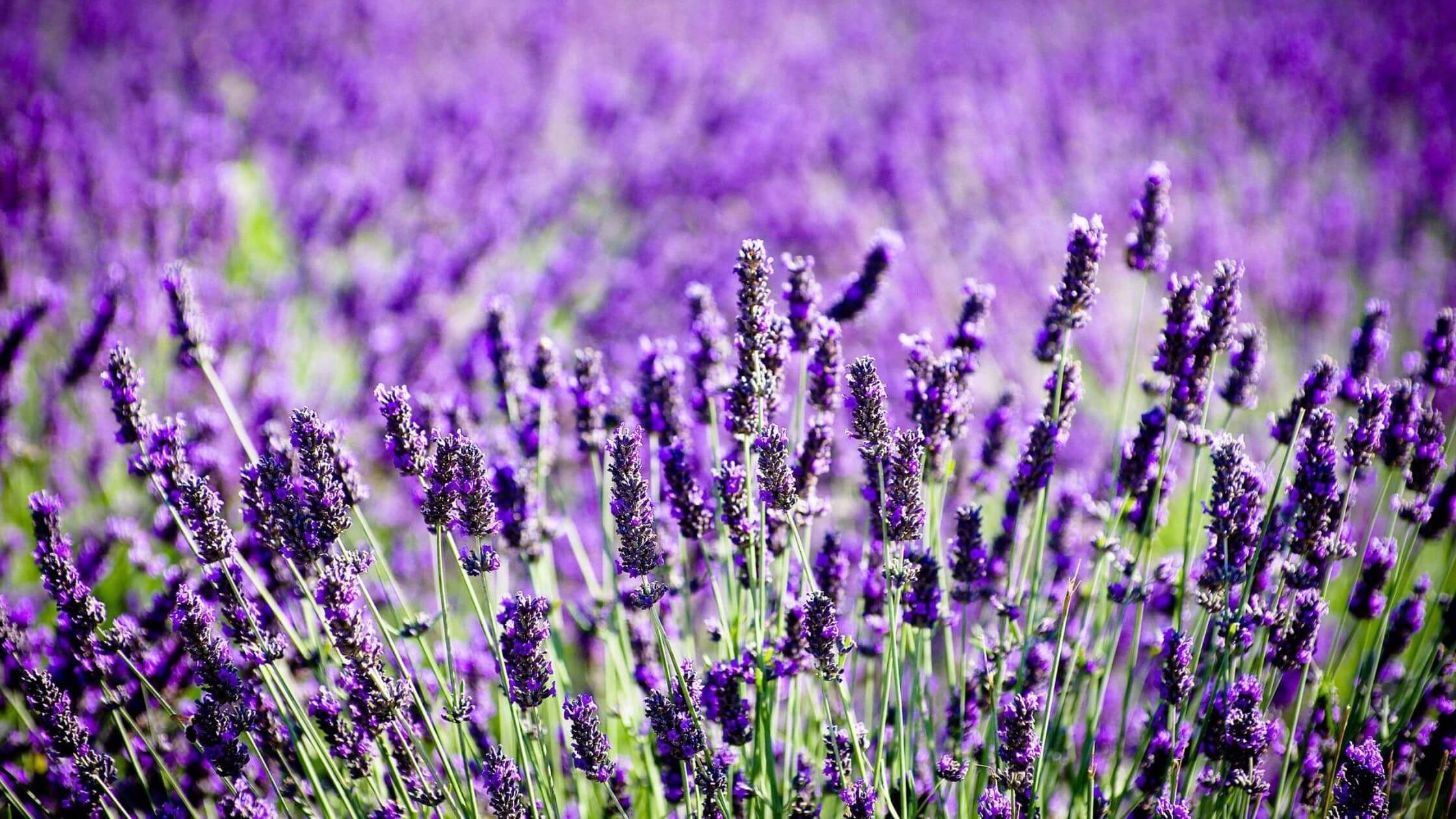
Lavender bushes bloom between May-July. (Image: Pixabay)
5.00 p.m. - 6.30 p.m.
After returning your bikes to the Riva, it’s time to head back to your hotel to complete the check-in process and freshen up for a casual evening in Stari Grad.
6.30 p.m. - 8.00 p.m.
For our final activity today, you may want to watch the sunset from Glavica Hill. While Glavica Hill is considered a hike, I’ve made it up with relative ease in just sandals (not the heeled kind though!). The path is well marked, and the entire trail is shaded by Mediterranean pine trees which provides some reprieve from the afternoon heat.
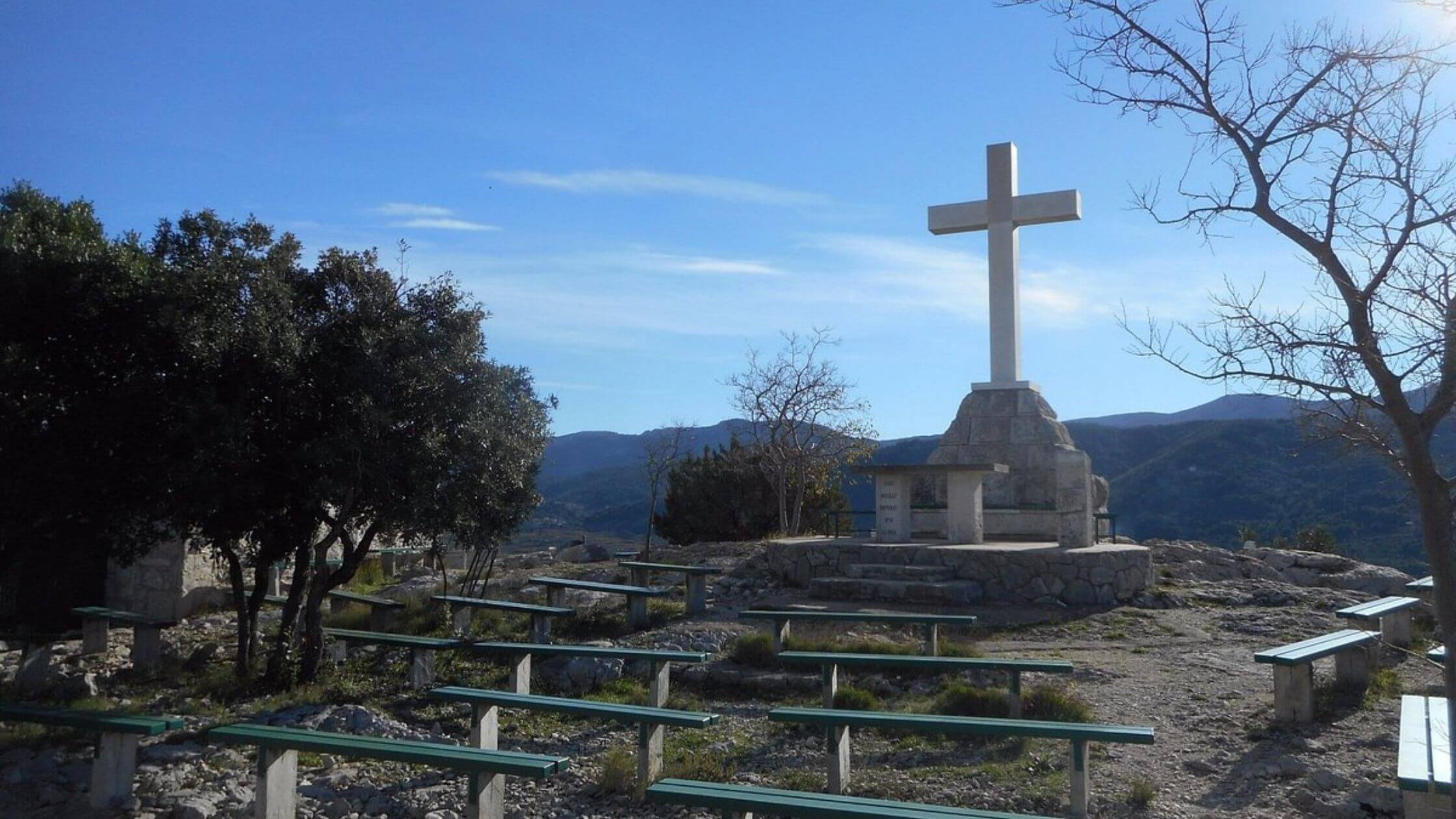
A breathtaking view awaits you at the top of Glavica hill. (Image: Steven D/Tripadvisor screenshot)
Before starting the 20–25-minute walk to the top, head to a grocery store or TISAK to grab a couple of drinks, so that you’ll be able to sit and watch the sunset as it illuminates Stari Grad and the neighboring island of Brač. The sunsets in Croatia are some of the most dynamic I’ve ever seen, with the horizon turning shades of blues, purples, oranges, and pinks before the teal blue of the evening blankets the sky.
8.00 p.m. - 10.30 p.m.
After a day of walking and biking, time to wind down at one of the most authentic, family-run restaurants in the city – Blue Doors Restaurant. With its courtyard seating, you’re treated to stunning views of the harbor, augmented by warm service and a romantic atmosphere, complete with dim lighting and soft music.
Try their seafood plate for 2, piled high with fish and seafood freshly caught that morning, and a Dalmatian signature, the black risotto made with squid ink. No meal is complete without a refreshing bottle of their own Prošip or Graševina, perfect for sipping on a warm summer evening while watching the fishing boats bob along with the gentle waves.
With such an activity-packed day, it might be time to wrap things up in Stari Grad in preparation for Part 2 in Hvar town where we’ll kick start the day with one of my favorite cafes on the island.
How to get from Stari Grad to Hvar by bus?
Getting around Hvar Island without your own ride is quite straightforward. There is only one bus service between Stari Grad-Hvar run by Čazmatrans. Bus services begin at 6.30 a.m. and run 7 times a day for the 30-minute journey, which costs around 25 - 35 KN (€3.50 - €5) per trip which you pay with cash when you board.
You may have noticed that our 24 hours in Stari Grad did not allocate any beach time in the crystal waters of Hvar Island, but the fun’s not over! I promise there’ll be plenty of time in the sun and sea when we reach Hvar Town. So, continue to watch this space for suggestions on spending 24 hours in Hvar Town!
(€1 = 7.54 kuna)
For more on travel in Croatia, follow TCN's dedicated page.
VIDEO: Classic Island Vibes and Vistas of Spectacular Summertime on Hvar
November 25, 2021 – From the epic medieval harbour of Vrboska and the buzz of Hvar town to the historic streets of Stari Grad and 250 kilometres of brilliant beaches, this new footage of summertime on Hvar is making us yearn for next season.
 © Goran Šafarek
© Goran Šafarek
Hvar Town is overflowing with life in summer. By day, families wander by the waterside or between restaurants in the old town. By night, bars and discos are vibrant and full. In Stari Grad, a constant stream of excited new visitors arriving by boat. Such scenes tell of the popularity of summertime on Hvar. Arguably, this is Croatia's most well-known island for holidaymakers.
 © Goran Šafarek
© Goran Šafarek
But, away from the throngs of people in Hvar Town and Stari Grad, there's a distinctly different side to this island. Famously, Stari Grad Plain (Starogradsko polje) on the interior looks much the same now as it did over 2000 years ago. That's how long grapes and olives have been cultivated here. Pretty rows of vines and fields of olive trees or lavender colour the landscape all over Hvar. Passing by these agricultural endeavours gives a better reminder of just how much room there is for everyone on Hvar.
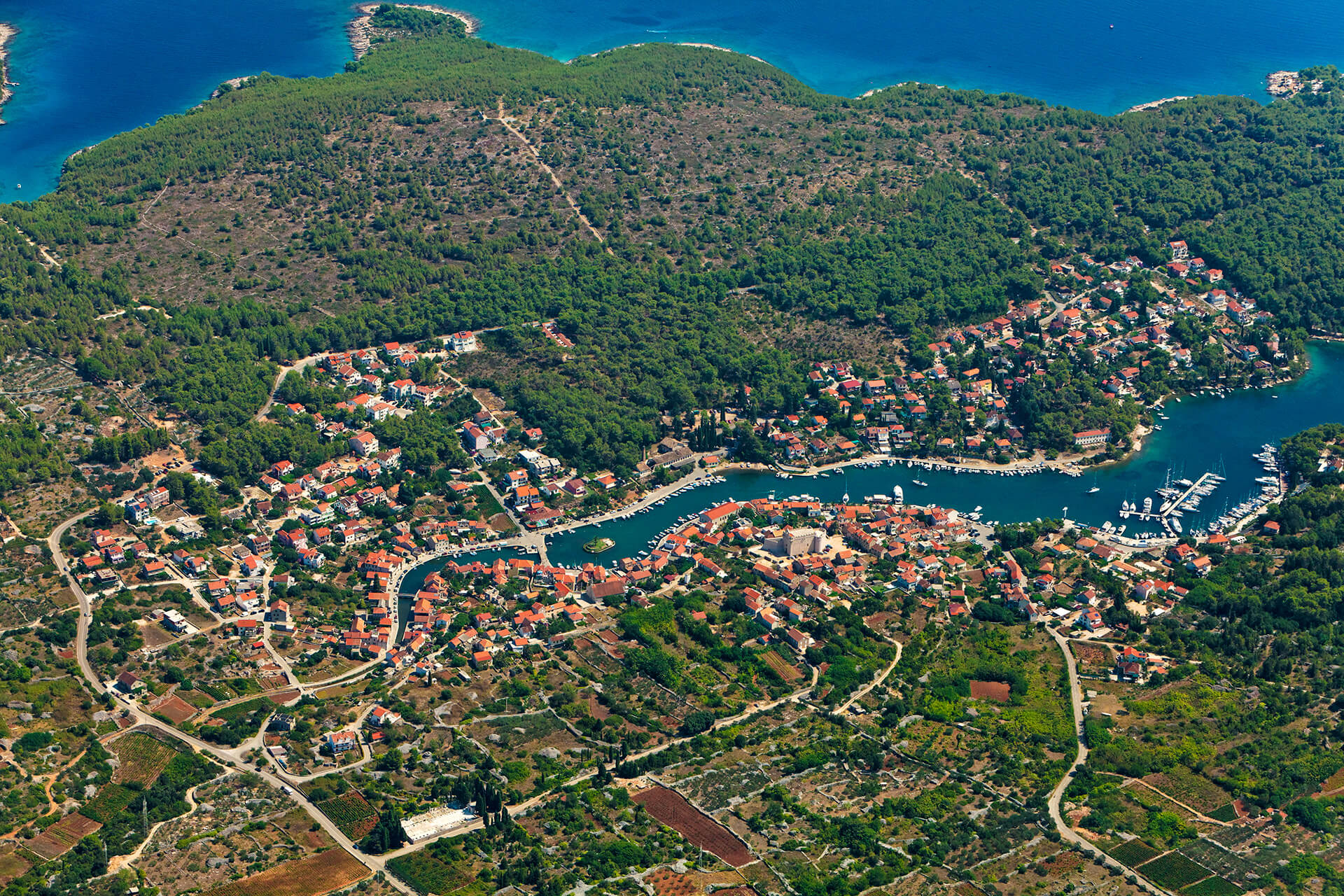 As shown above, the long, ancient harbour at Vrboska © Goran Šafarek
As shown above, the long, ancient harbour at Vrboska © Goran Šafarek
With 250 kilometres of its own coastline, Hvar is not short of beaches. People love swimming in the island's crystal clear waters. Sailors love them too. In the ancient harbour of Vrboska, there's an altogether different feeling to arrivals by boat. Here, elegant yachts gracefully cruise into the long, thin harbour. They find temporary homes near small, traditional fishing boats. Inside, summertime sailors may have chosen this beautiful part of the island because of its famous restaurants. After the gastronomic joy of lunch, maybe they'll wander the historic promenade or visit one of the famous winemakers near here.
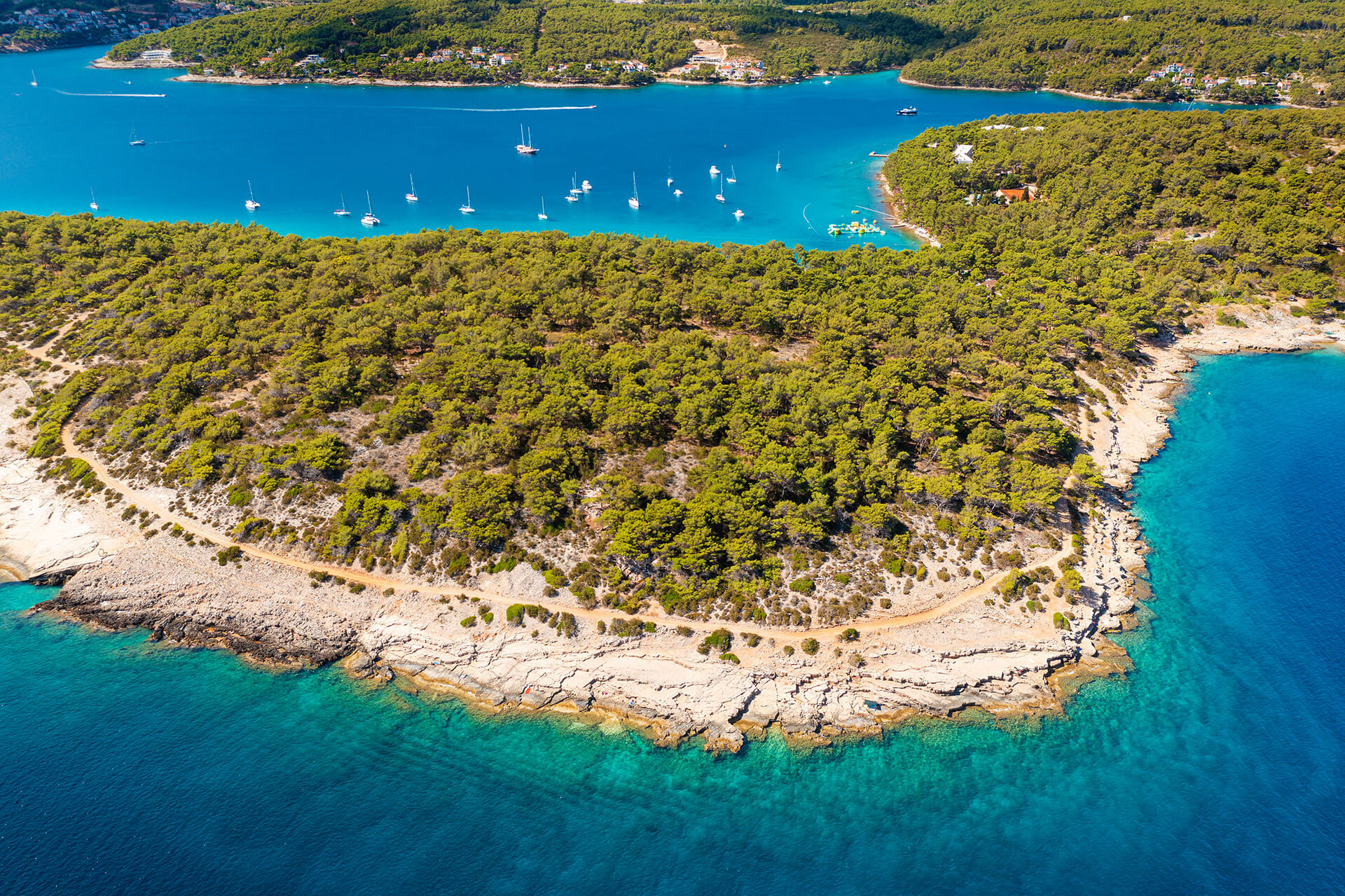 In the background, sailors into Vrboska © Goran Šafarek
In the background, sailors into Vrboska © Goran Šafarek
All these different aspects of summertime on Hvar and more have been captured in an all-new video made by Goran Šafarek. Goran, who is an independent biologist, publicist, photographer and filmmaker, was on the Adriatic working in summer 2021. His assignments included film work commissioned by Croatian National Parks. But, he took advantage of being on the coast and made time between assignments for a family sailing holiday. He visited Korčula island and Hvar island, using the opportunity to make new videos of each.
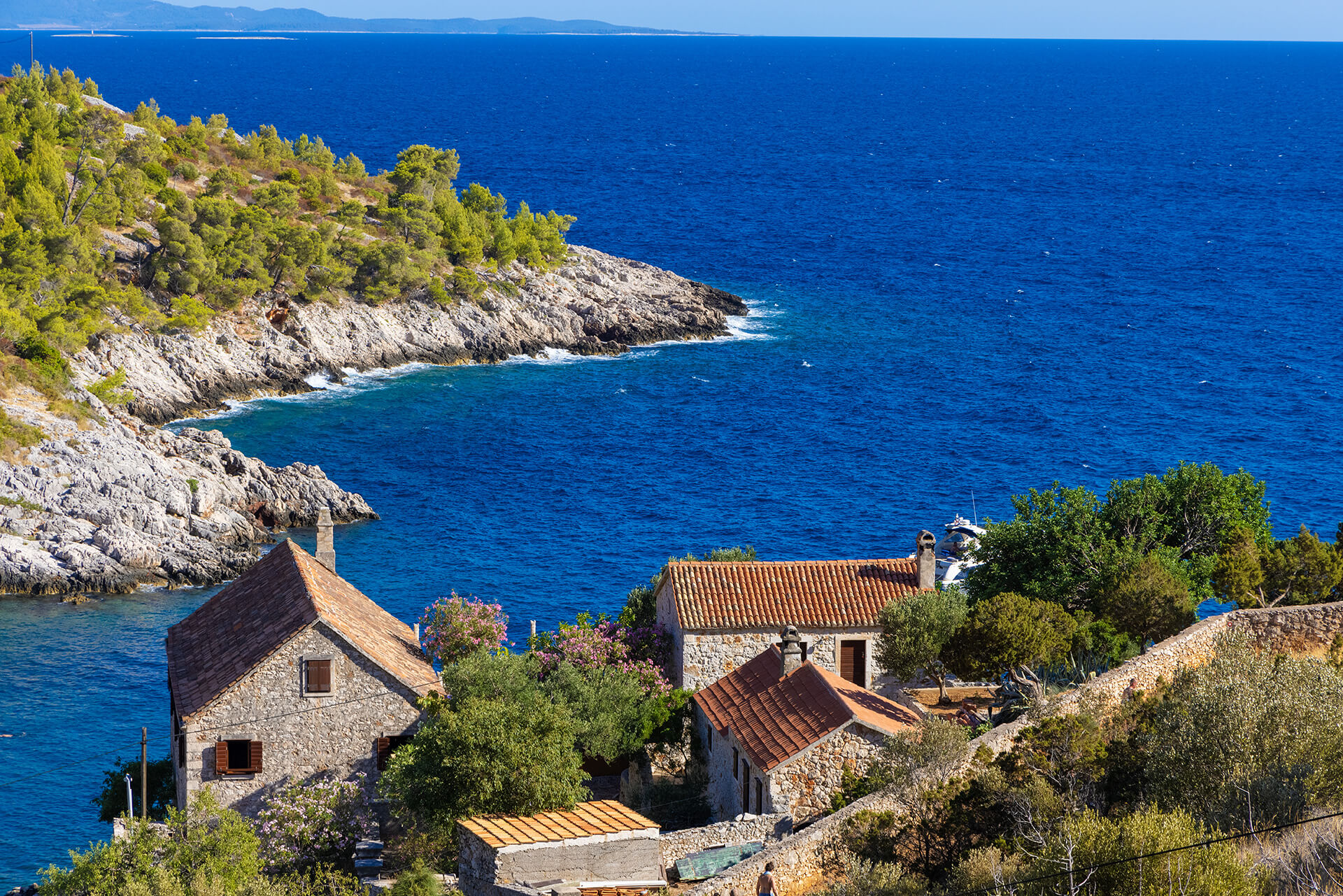 © Goran Šafarek
© Goran Šafarek
Total Croatia News has already published Goran's new video of Korčula, which you can watch here. This new one of Hvar has us pining for summer and making plans for next.
For more info about Hvar island, look here. And for the latest news from Hvar, bookmark Total Croatia News pages here
Croatian Author Igor Pavela on Hospitality and His Scientific Book
August 12, 2021 - Croatian author Igor Pavela who wrote the first Croatian scientific book on hospitality, is currently waiting for the book to be translated into English. TCN reporter Ivor Kruljac met up with Pavela to discuss both the book, but also the current situation in the Croatian hospitality sector.
April 2021 saw the release of ''Excellence as a Standard in Hospitality Business'' (Izvrsnost kao standard u ugostiteljskom poslovanju), the first Croatian scientific book on hospitality in which author Igor Pavela explored what it takes to successfully run a business and ensure both an excellent offer and enjoyable atmosphere for the guests.
The book's author, Igor Pavela, has been in the hospitality business for the past 16 years. He has gained invaluable experience in various aspects and from multiple positions. Back in April, he was a manager in one of the largest American cruise ship companies and today works for the Maslina Resort in Stari Grad on Hvar island.
He has closely worked with top managers and CEOs of various big international tourism and hospitality companies in his rich career, and he also found time to train management and other employees with his educational material helping them to increase the quality of their overall standard. The educational materials Pavela has written for his training sessions eventually pushed him to write this book, now reviewed and praised by the academic community both in Croatia and in the wider region.
The book boasts a combination of his personal work experience and extensive scientific research encompassing marketing, communication and even ethics (to name just a few), and how one can go about applying it to hospitality sector success.

Maslina Resort management team. From left to right: Mario Kolumbic Maitre'D , Chris Edwardes as consultant, Igor Pavela Bar Manager © Maslina Resort
Ground rules in one place
With academic opinion being relevant for knowledge when it comes to scientific literature, Pavela, at the very start of the interview, also said that the first version of the book, which was constructed as his personal business manual, was reviewed by his close friends, colleagues, and ex-partners, all those who have been established in the hospitality business for decades.
''The first information I got as their feedback was that they'd never seen such valuable information presented in a way which is both easy to read and easy to implement. It combined the scientific research that provides the facts and my personal experience which I tried to pass on in the book like a tutor would in order to say what works and what doesn't,'' recalled Pavela.
Pavela pointed out that the hospitality sector encompasses a very broad range of occupations, and there are differences between cruise ships, fine dining restaurants, nightclubs, hotels, and other types of hospitality businesses. With that being said, there are also basic ground rules that are the same for every type of function. His colleagues who learned what works in business the usual way, by experimenting and seeing how things work out before changing and adapting things, rated the book in such a positive way, and Pavela looked more than happy with the impression his writing had had on others in his field so far.
With support from University College Aspira that both published and also held a book presentation for their former student, significant developments are happening for the book as it is currently being translated into English. With the global market not really having a scientific book of this kind under its belt yet, the options seem endless once the translation is complete. Ambitious but realistic, Pavela revealed further plans for the book.
''The book just recently came out in April (it could've come out earlier, but we waited for the unprecedented and catastrophic period for hospitality as a result of the pandemic to calm down). The translation will take around a month and a half to be completed by a professional agency that we hired, and after that, it will be reviewed. As the Croatian version was given to three doctors of science to be reviewed, it will also be reviewed by three very well-known and established names before going out onto the European market. They will, upon agreement, get an example of the book to review it and score it objectively,'' explains Pavela.
He continued by explaining that the book is now the subject of negotiations with a very known high-level sponsor in the hospitality sector. While not being able to reveal the name of the sponsor, Pavela says this sponsor plans to open an academy and to educate their staff based on Pavela's book, which is making its way to hospitality-related education in Croatia, from those in high school to those in higher levels of education. In addition, there is a plan to distribute the English version as an electronic book. The plan is to connect with big e-book distributors such as Amazon to make the book accessible globally, for students, professionals, those who want to start their business and those who are just curious readers with a desire to learn more.
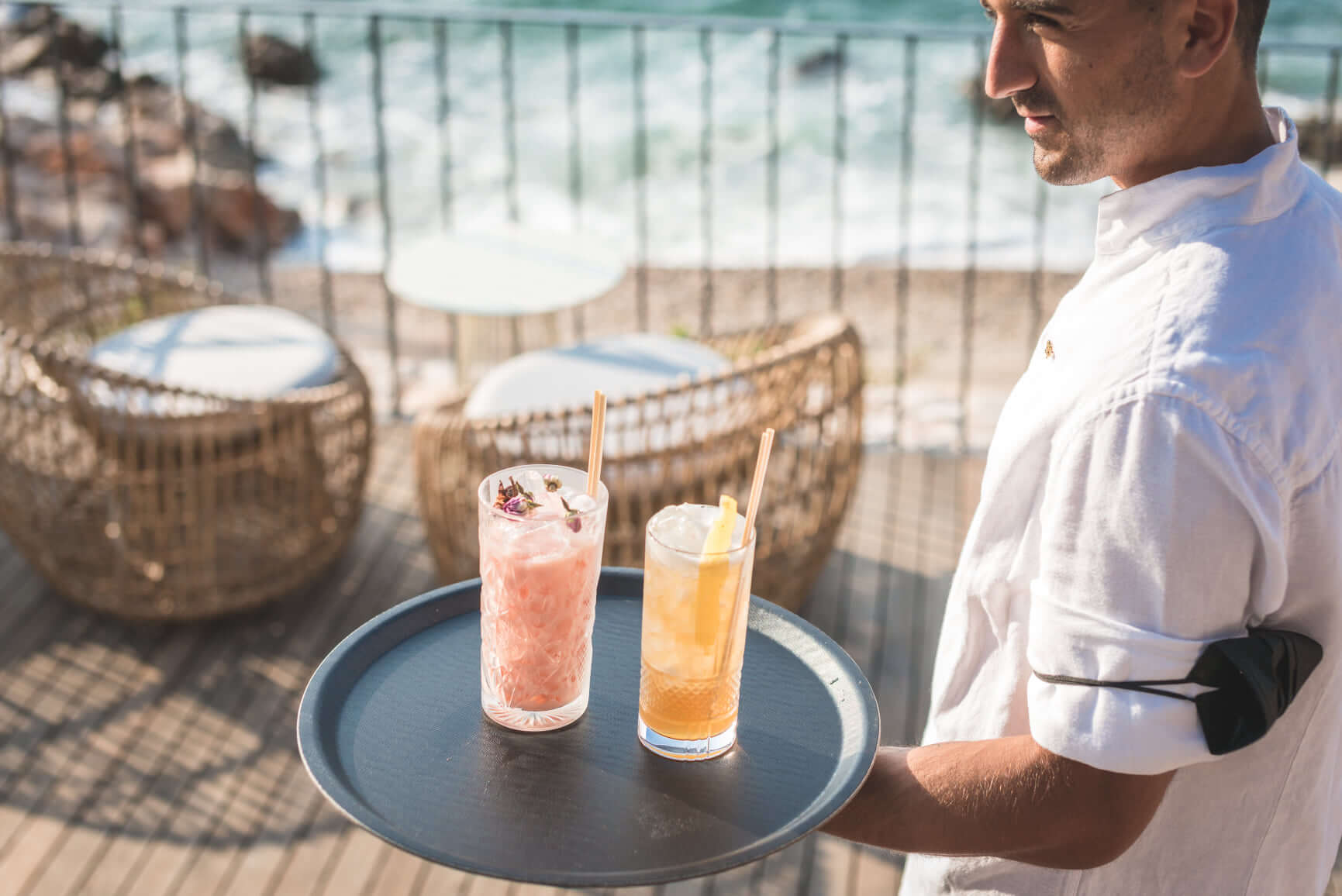
© Maslina Resort
Switzerland is the place for experimental physicists thanks to CERN, Japan is doing wonders in robotics, and American and British scientists are making significant historical contributions to the fields of sociology and anthropology. Maybe this book would position Croatia as a leader in scientific observations of hospitality. When asked about this, Pavela said that it is a wonderful idea, and his greatest desire.
"My first intention when I started writing this book was to collect all global experience, which is different, if not more advanced than what is garnered in Croatia alone. I wanted to bring it home because at the end of the day, this is my home and where my heart belongs. Croatia has natural resources that need to be used more, and that also means not just promoting them, but we should be on the level required to be the high-level destination to attract high-level clients from all over the world.
I think Croatia, unfortunately for years now, hasn't been at the required level, and there has been a sea of negative comments from guests as a result. There were good sides too (tourism has been growing more and more since the Homeland War), but from the side of science, we have to see the negative sides because that's something we need to look at in our analysis and research to see what is wrong and why something is wrong so that we can work on it,'' explained Pavela.
The up-to-date research needed to scientifically and successfully explore what works and doesn't work truly needs to be constant, and the spirit of that mentality is reflected in the fact the book already has references and findings in regard to COVID-19.
Hospitality isn't just business but a purpose, too.
When it comes to things that need to be worked on, Pavela pointed out that many people in Croatia who work in hospitality are students and people who don't really take much interest and aren't really educated in the sector, thus bringing down the level of the country's hospitality services in general.
Within twenty minutes of interviewing Pavela, it became clear that he talks about hospitality with the kind of passion that isn't unusual to see among journalists or maybe even lawyers and doctors for their fields, professions who are generally quite romanticised in pop culture and where workers in the field don't view it as a job to put food on the table, but rather a call to contribute to better future. However, it is very unusual to recognise such passion for hospitality among people. How does one find such a spark in an field most people only view as a side job to achieve some higher goal? I asked.
''In one specific moment, I saw hospitality from a completely different level. I was still involved in the operational part of the industry, the back of the counter, serving and having conversations with hundreds of people every day. At one point, I had this click in my mind where I realised that just as food and water are a necessity for the body, these places of socialising are food for the soul that will not disappear even as the world changes with all this technology,'' Pavela said, recalling how he first fell deeply in love with hospitality.
He looked around the beach bar where we sat with delight, which, if more people could recognise it, would no doubt make your morning coffee in a cafe be taken in with a completely different view.
In recognising the energy which takes place when socialising after a hard day at work or school, he saw all members of the hospitality sector, from the highest decision-making managers to the waiters, as actors all involved in the collective task of making socialising as good as it can be.
''Hospitality isn't just an economic transaction of buying a product, here we offer so much more. Our service can make someone's day,'' said Pavela proudly, reminding me of how business deals, relationships, friendship and so much more is formed in a great atmosphere of hospitality service, thus really making a difference to the world.
Maslina Resort's Mediterranean John Dory © Nikola Radovani
As you read through the book, Pavela stays true to his words, pointing out good examples but also bad ones from which other employees and owners can learn what to avoid. Despite positioning some of the aforementioned negative practices to his hometown of Split and the wider Dalmatia area, Pavela at no point mentioned a specific name or a venue that fitted any negative practices. Pavela is sure this doesn't damage scientific data and gathered knowledge, and his scientific objectives are evident in him not name dropping people or places that have good practices either. In this way, he avoided the potential accusations that his book is either paid trash talk or a paid word of praise for some business, which would put a serious strain on Pavela both as a scientific observer and as a hospitality professional.
''When you're writing something like this, it's a very sensitive thing. The purpose of the book isn't to call anyone out for doing bad things, and I don't think that should be in the book. If somebody does something bad and it ends up in the news or with them being sued, then there are other ways to learn about that. The book is about focusing on changing bad practices to positive ones, and even though I had specific places and names in my head, I didn't want to bring them out and sound unprofessional,'' explained Pavela.
''What I want is for those people behind positive and negative examples to recognise themselves,'' he said.
Solidarity should trump competition when building a destination.
In the end, this book of science and practice has an aim of helping others improve their own business. That wouldn't be weird if Pavela had already retired from the business, but with his active employment for Maslina Resort, an outsider's point of view might leave you thinking whether or not it is wise to ''spill the beans'' and all the tricks of the trade as direct competitors could out beat the master as the students of his findings and knowledge. That's a very logical question from outside, but Pavela only smiled with confidence as he assured me that this book's release would neither sabotage himself nor his colleagues.
''The beautiful thing about hospitality is there is something for everyone. The more types of hospitality we have present in our destinations, the better, because opening a new bar doesn't mean stealing guests from another bar. It means offering something different. Everyone can find something for themselves. Somebody will want to hit a brew bar. Someone will want a clubbing experience, and so on. Passing on knowledge is not damaging any of the places. The point is that we all grow together in terms of quality and the commitment to what we do,'' elaborated Pavela, revealing solidarity in hospitality which is hard to deduce from the guest's point of view.
As his book clearly elaborates on, it is wrong for a hospitality owner to try to catch everything and everyone with his offer. Specialising and targeting a particular audience (e.g. those who love quality food and wine, leaving out those who want cocktail bars as you focus on improving your gastronomic offer), along with investing in quality ingredients and keeping your workers happy are the key to success, as Pavela mentioned himself. These are just a few of the points you can find in the book, but in the end, it's best you read it for yourself here. Either in Croatian or you can wait a little longer for the English version.
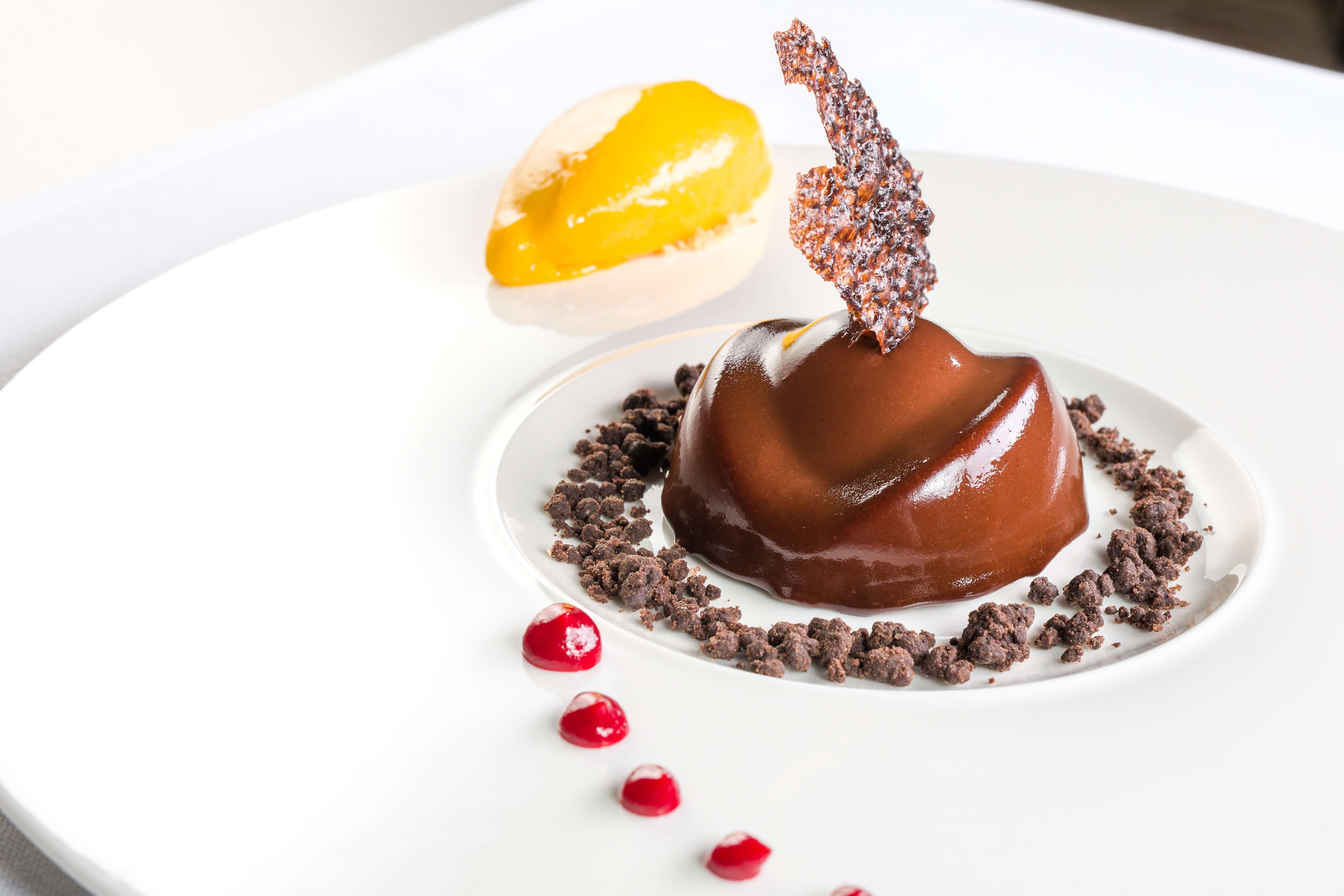
Maslina Resort's Chocolate Cherry Sphere © Nikola Radovani
It's worth remembering that science never sleeps, and with Pavela himself warning of this - the situation is changing constantly. Today's top formula for happy guests may be completely outdated tomorrow. Researching and learning are always welcome in order to show all those involved in this industry the way to providing the best service possible.
Learn more about Stari Grad on Hvar on our TC page.
For more about science in Croatia, follow TCN's dedicated page.
Vinarija in Stari Grad to Unite Most Valuable Natural and Cultural Resources in Area
April 24, 2021 - In cooperation with the Ministry of Agriculture and the Ministry of Culture, Vinarija in Stari Grad will sustainably unite the use and promotion of the most valuable natural and cultural resources in this area.
StariGrad.hr reports that after successfully purchasing and obtaining the use permit, the main project will be drafted, the realization of which will once again make Vinarija an important driver of the Stari Grad's economic development.
The Vinarija revitalization project is being developed in cooperation with the Ministry of Agriculture and the Ministry of Culture. Its goal is to sustainably unite the use and promotion of the most valuable natural and cultural resources in this area.
The new facility will be managed by the Stari Grad Plain Management Agency, which will get a new headquarters and an additional segment of its business in Vinarija. In this sense, new spaces and facilities have been conceived within the Vinarija building, which will become a central tourist point for visitor tours and the presentation of the overall historical heritage of Hvar Island.
There, tourists and visitors will be able to taste and buy local products from local producers who will bring their wines to Vinarija, bottle them, brand them, store them and sell them.
In addition to wine, the production of essential oils and herbal products is also planned, which will also be sold on the shelves of local product stores located within the facility.
The new production and presentation complex will be a significant added value in the tourist offer and valuable help to local producers who will place their products under a unique and recognizable brand in one place.
During the development of the project, workshops will be organized where all interested parties will receive detailed information about the implementation of the project, and the developer will provide valuable feedback to help define the final details.
The main project will be prepared to meet the main objectives of the Vinarija and Stari Grad Plain revitalization and the EU funding project requirements, as it will be followed by applying for EU funds and providing the financial basis for successful implementation.
For more about lifestyle in Croatia, follow TCN's dedicated page.
Cabaret Show and Great Wines Thrill Stari Grad on Hvar
A Cabaret Show and some drops of excellent wines thrilled Stari Grad on Hvar on Thursday evening, when the wine and stage spectacle was held in the amazing atmosphere of the open-air theatre. The performance was dubbed the "pocket-sized musical", and it has attracted many inhabitants of Stari Grad and their guests, so the theatre was completely full.
Those who managed to find a seat for themselves enjoyed an hour and a half performance of Cabaret à la Carte, partnered by the wines and hard liqueur by Dalmacijavino. The people attending confirmed that the evening was a success, that the musical performance was wonderful, as were the good wines that accompanied it.
The event was organised partially to be a promotion of R'kaciteli, a new addition to the wines made by Dalmacijavino, a fresh, summery white wine, originating from Georgia, that has been cultivated near Drniš since the eighties, since it's quite sweet and works well when blended with Dalmatian varieties. This is the first time the variety has been produced in Croatia as a monovarietal wine, and the first impressions of it seem to be exceptional.
The local media said that the event was a great addition to the already excellent tourist-oriented programs, and many people have shown the desire to see a reprise in the future. Andrea Previšić from Dalmacijavino's marketing said that they wanted to give to the wine-lovers an evening to relax and enjoy the moment. The reactions are great, as are the compliments to the wines, and that is something that makes Dalmacijavino happy. The Wine & Jazz festival starts soon on Hvar and Brač and Dalmacijavino wines will be a part of that event too, so she invited music and wine lovers not to miss that event!
The Wine and Jazz starts on July 22nd in Stari Grad, Hvar, Jelsa and Bol on Brač, as a unique event on the Croatian coast, bringing together wine and food with the great music.
Eight days of the program will be filled with some of the world's top jazz musicians, as well as numerous lectures, exhibitions, movie screenings, presentations and wine tastings by some of the best winemakers from the region. The music will be provided by Cubismo, Jazzoleptic with their amazing lead singer Nikola Marjanović, Mihael Parušev trio with singers Jana Fabijanić and Habiba Menaz'Dear, Gadjo Manuche gypsy jazz band, and deep house/jazz duo by Jan Kinčl and Regis Kattie.
For more stories on Hvar, go to our destination page: Total Hvar
Over-Tourism? Meet the Chilled, Historic Ancient Town of Stari Grad on Hvar
June 26, 2019 - As tourists fill up the roads, beaches and bars in the summer heat, meet one ancient and relaxed island destination with its own cooling system, where time stands still.
It is a strange feeling walking around a tourist island where you used to live, looking at towns and villages where you used to know every shop and bar but have not visited for years. Especially in the searing heat of 30 C - far too hot for this pink Englishman. The thought of heading to Stari Grad on Hvar in the midday sun for some meetings was not one I relished.
But then I remembered something about Stari Grad - just how cool it was. Not in the sense of stylish cool (it is very much that as well), but a haven from the heat.
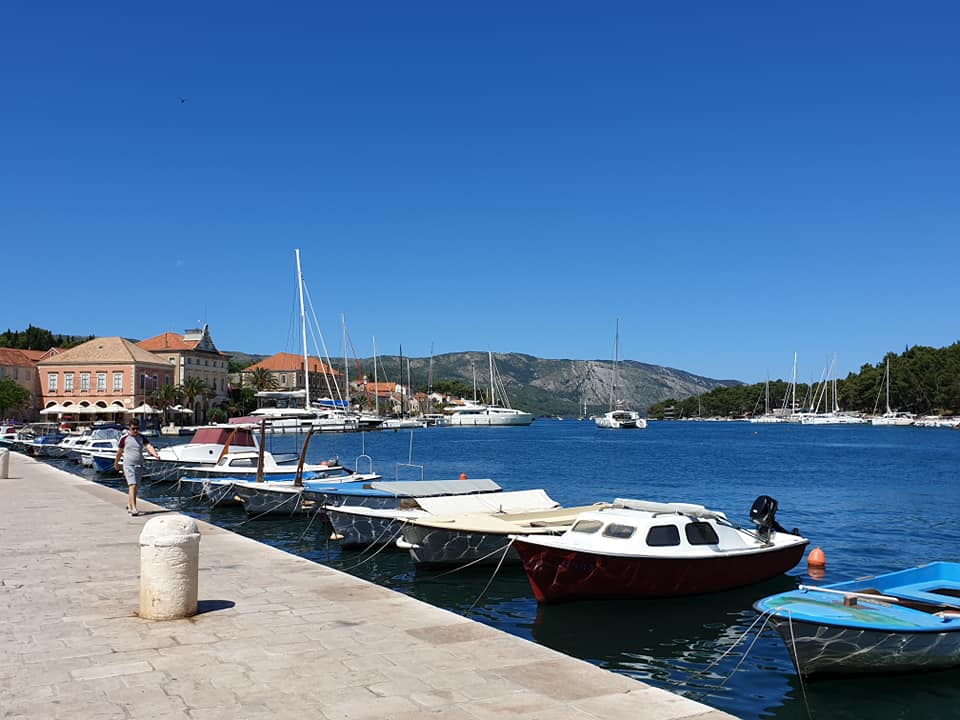
Stari Grad has a timeless quality where nothing seems to change, and yet things are changing very nicely, as the destination retains its historic charm while upping the level of quality. It is one of the most underrated destinations on the Adriatic, one of the most vibrant island towns 12 months a year, and a destination which is not exposed to the mass tourism one experiences elsewhere. It has always been for me the heartbeat of the island, home to the main ferry, shopping area and court, to name but three.
And walking around the idyllic old town for the first time in years, I fell in love again and noted that while nothing had changed, a lot had changed.
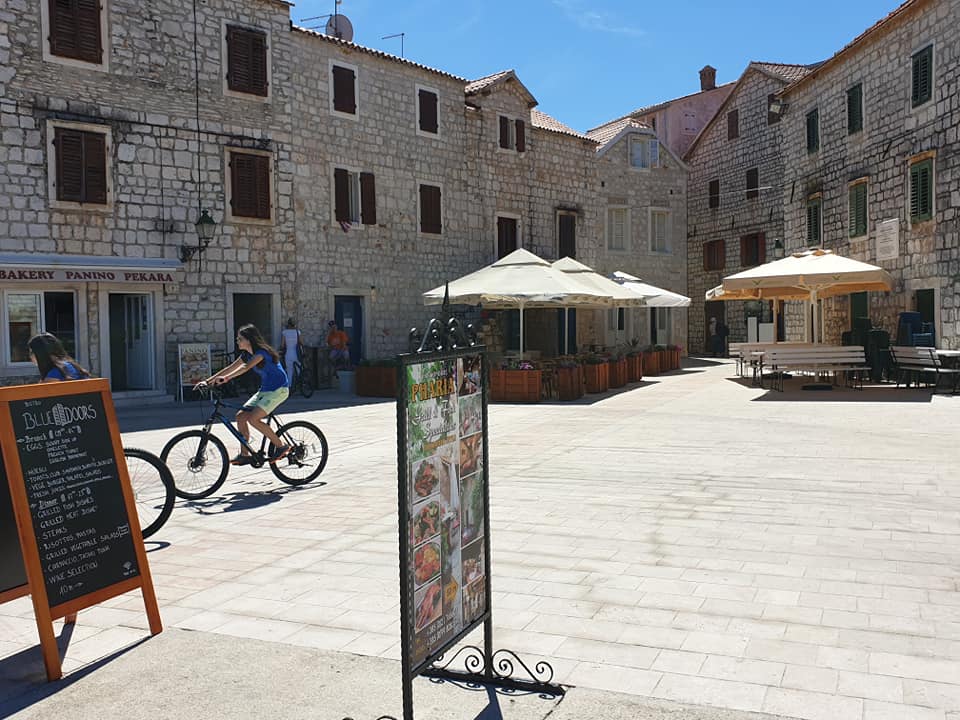
The abundant squares in various locations of the old town, which was founded by the Ancient Greeks 2400 years ago (along with the nearby UNESCO World Heritage Site, the Stari Grad Plain) have changed little over the centuries. They are connected by a warren of cobbled pedestrianised streets where you can easily get lost, but not for long, as the old town is perfectly sized to explore without getting disoriented. Cyclists were a constant theme as I wandered round, as tourists took advantage of the space and slow pace of life to explore.
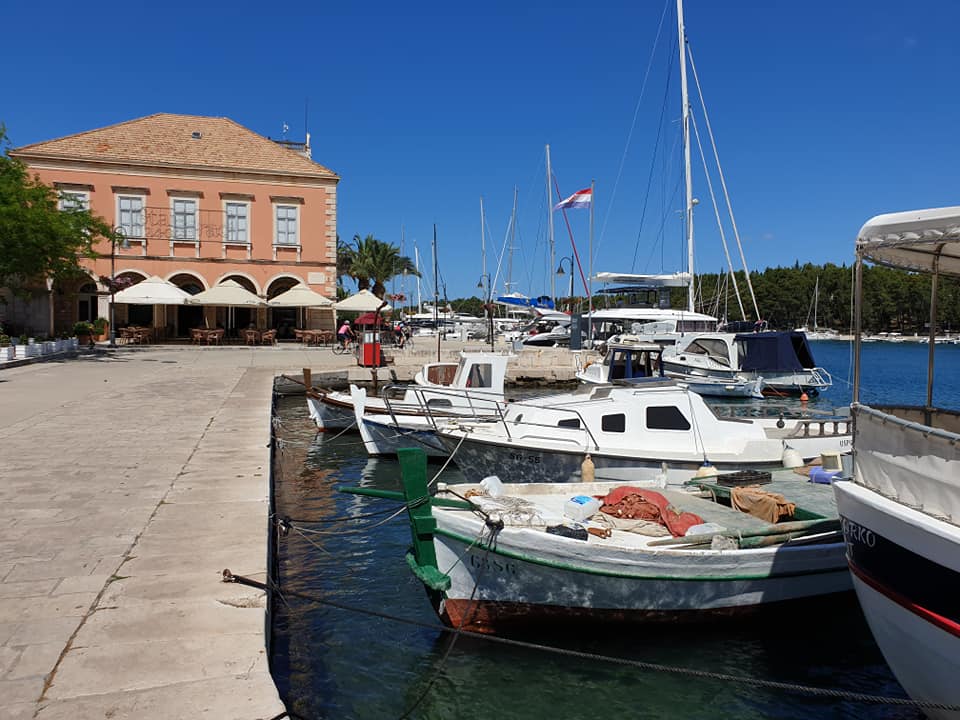
Stari Grad's deep bay has long made it a favourite port of call for sailors, ever since the Greeks sailed in in 384 BC, and the extension of the riva in recent years has made it a magnet for sailing companies, whose shiny boats coexist peacefully with the local fishing and taxi boats.
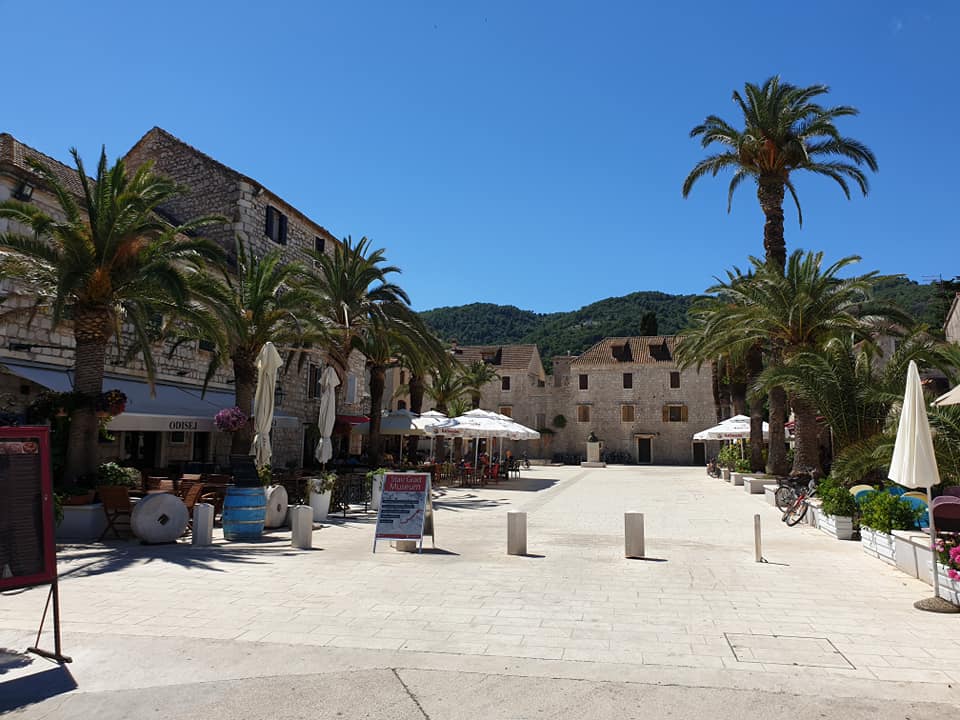
The 2400 birthday a couple of years ago was accompanied by some upgrades to both the infrastructure and parts of the old town, including a repaving of Hektorovic Square, which gaurds the entrance to the famous fortress and fishpond of famous 16th century Croatian writer, Petar Hektorovic.
Coffee o'clock any time of day.
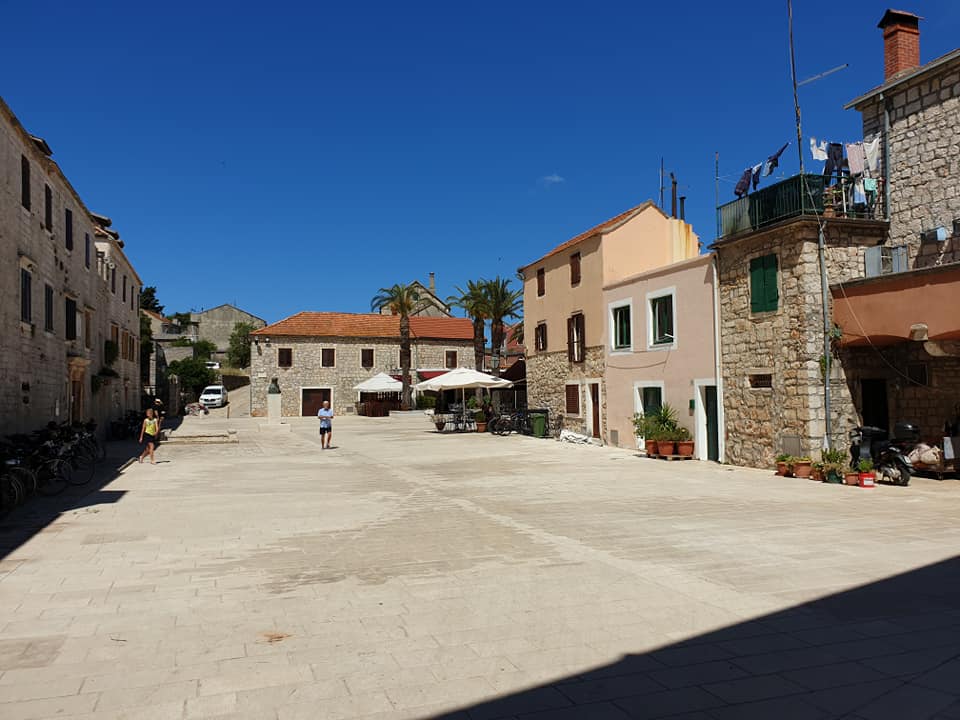
So much space, such a delightful chilled pace of life.
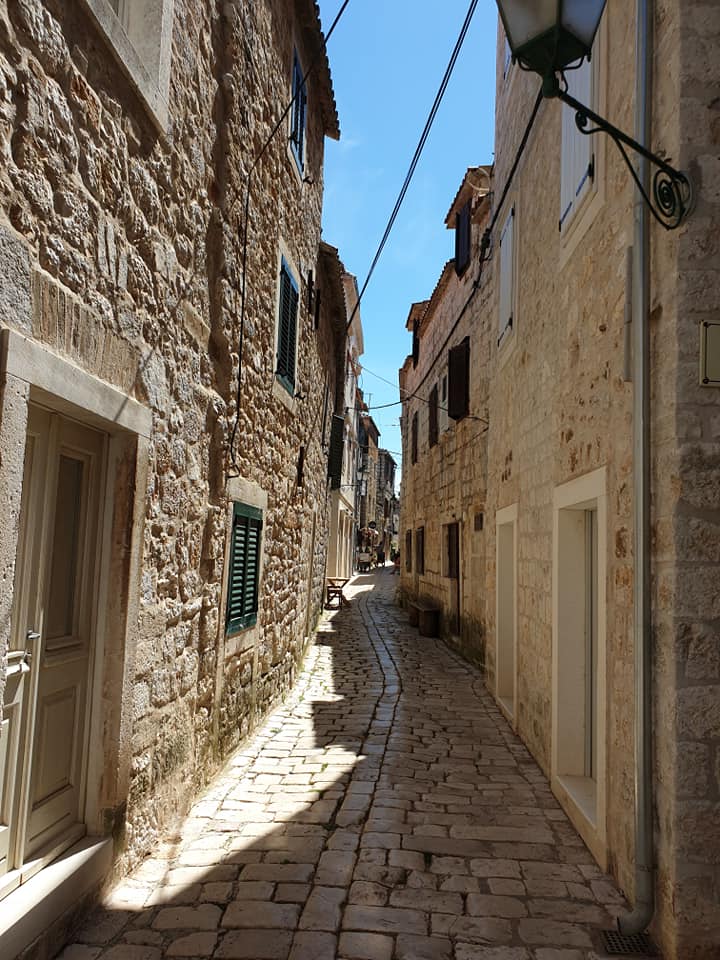
And also a chilled place to walk in the midday heat. The old town of Stari Grad has always been much cooler than any other place on the island for me, a wonderful and relaxed place to walk around with its alleys to explore, and several degrees cooler than out on the waterfront. And with most people at the beach during the day, walking around the ancient squares and alleys not only keeps the heat at bay, but gives you the chance to see authentic Stari Grad without having to share with many others.
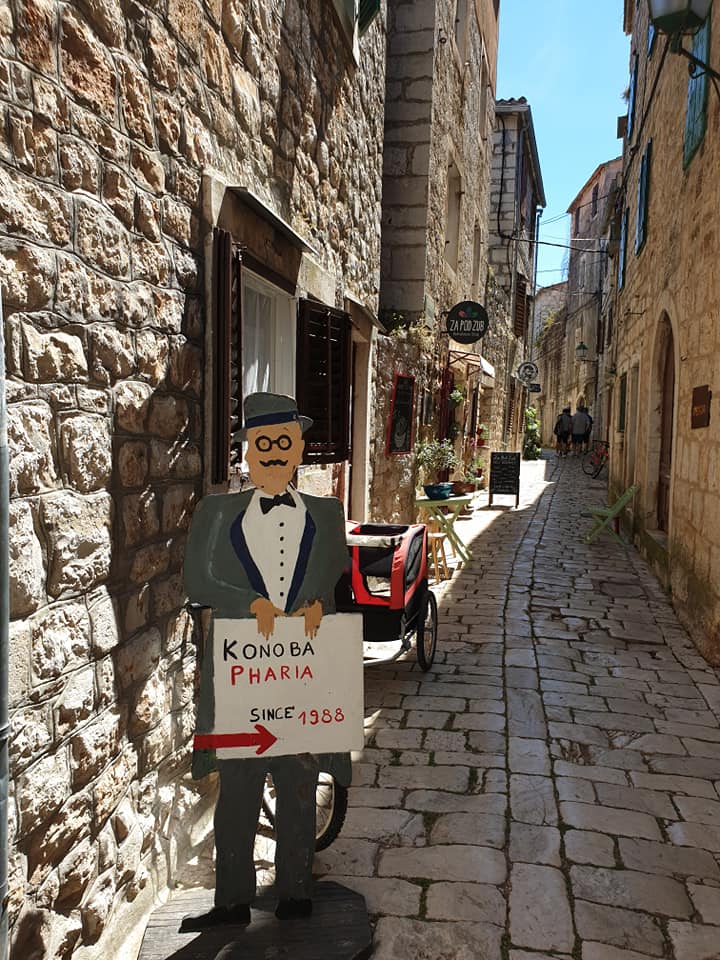
A lot of the restaurants have been there for years, and new ones are springing up. Apolon became the first Hvar restaurant to make the Michelin guide last year.
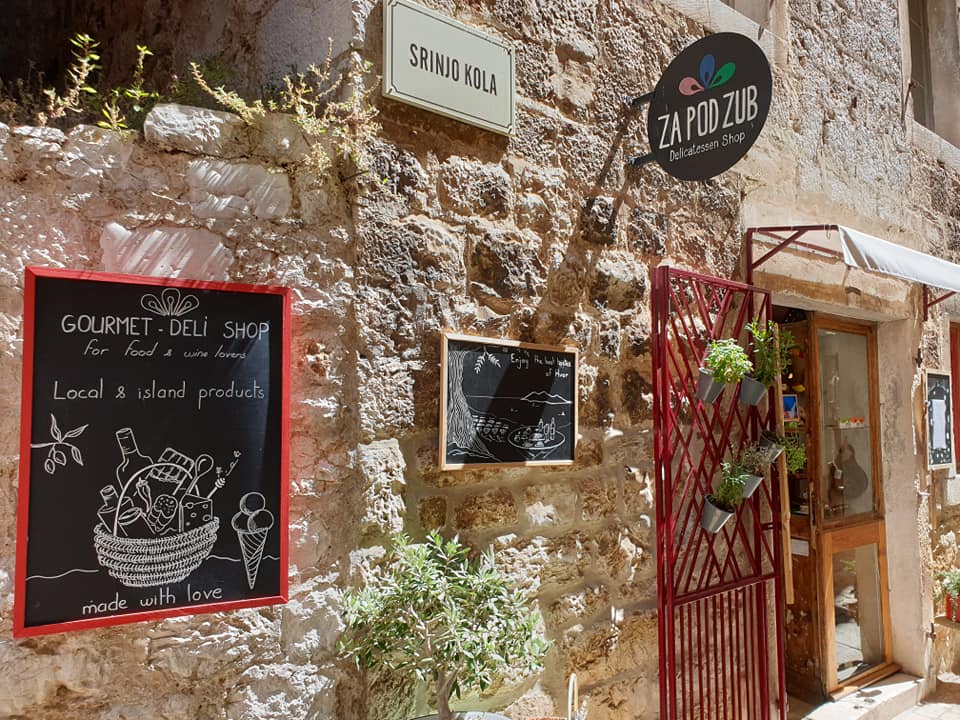
What has increased a lot in recent years are the artisan and local product shops, such as Za Pod Zub - done with passion and love and adding to the already considerable charm of the town.
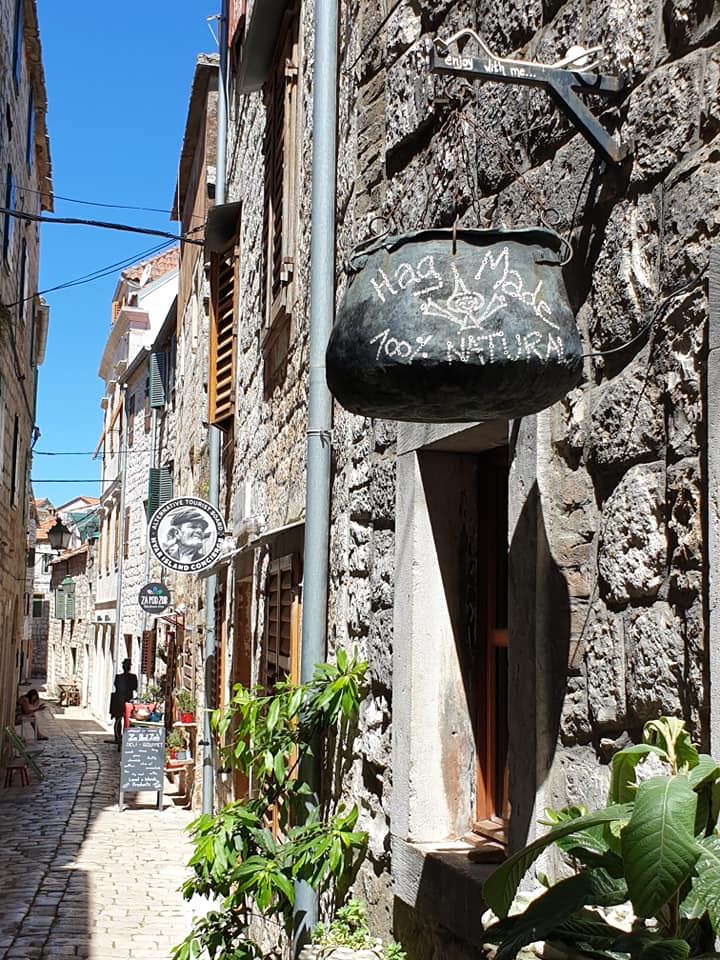
I really liked the signage too, nothing brash here, just stylish advertising of stores that added to the ambiance.
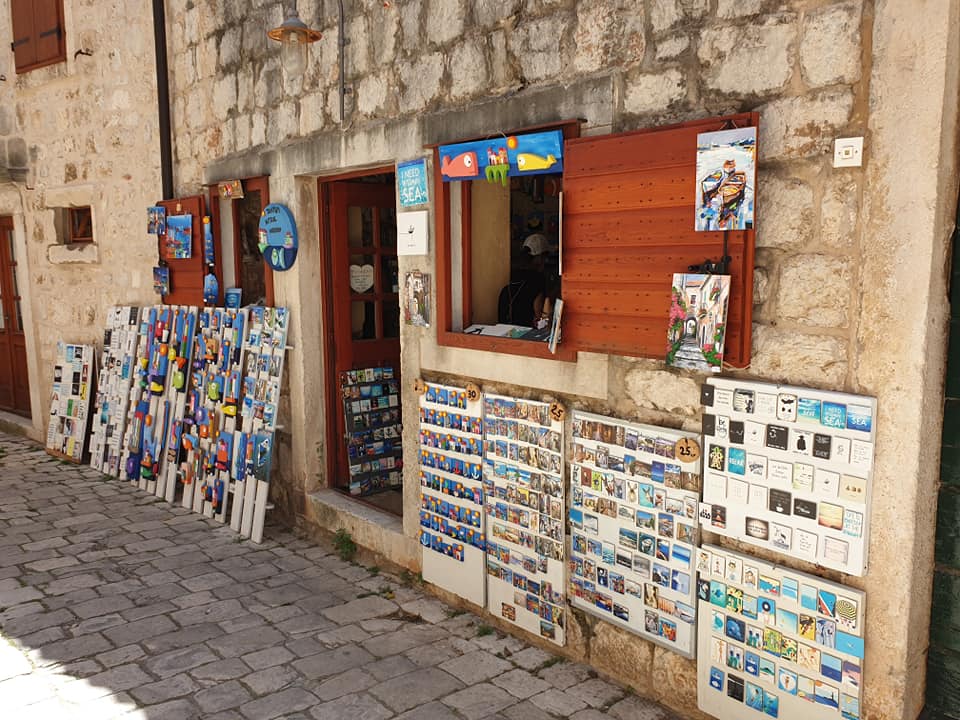
Stari Grad has long been known for its artistic scene, and there are several art galleries, art shops and numerous museums here. What to do when it rains on Hvar (if we can remember back to the days of rain)? Stari Grad would be my top recommendation, as it offers a lot of indoor cultural activitiy.
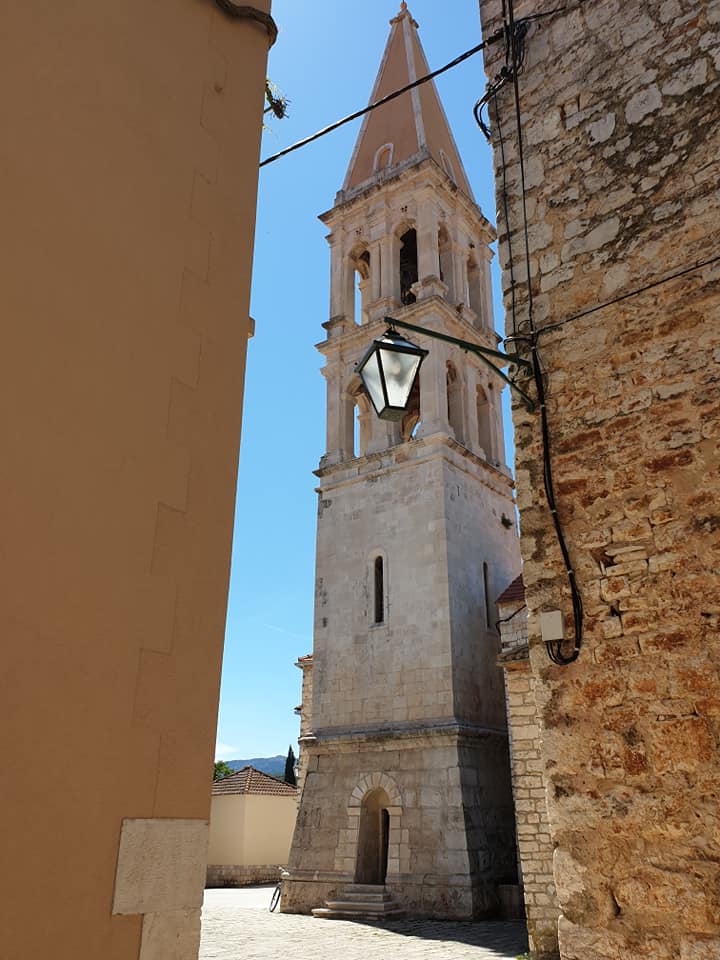
And churches.
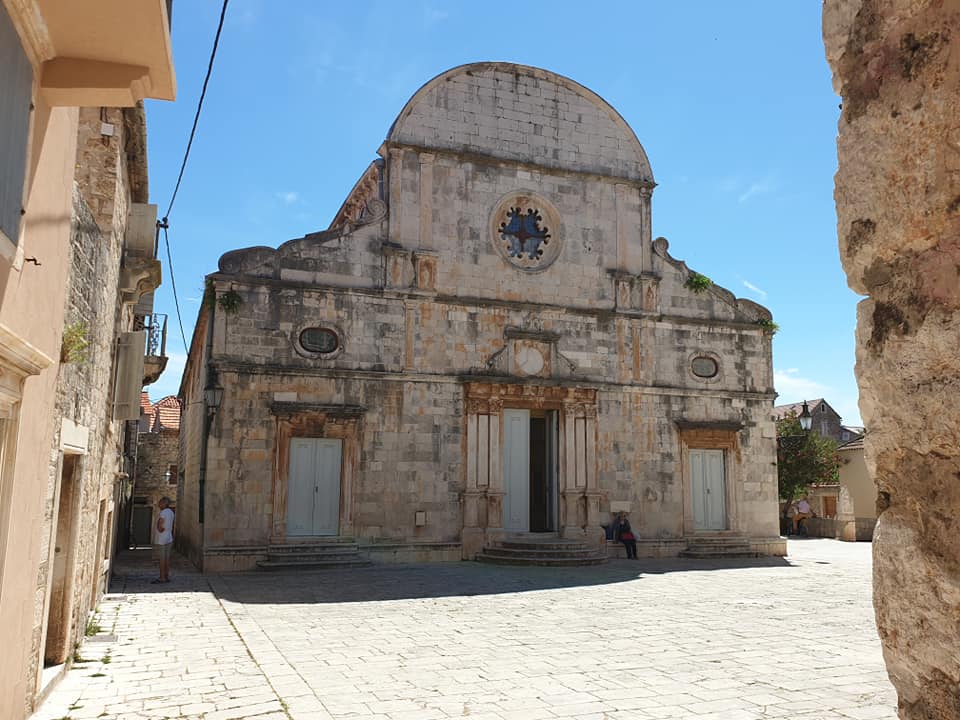
The magnificent cathedral on St Stephen's Square.
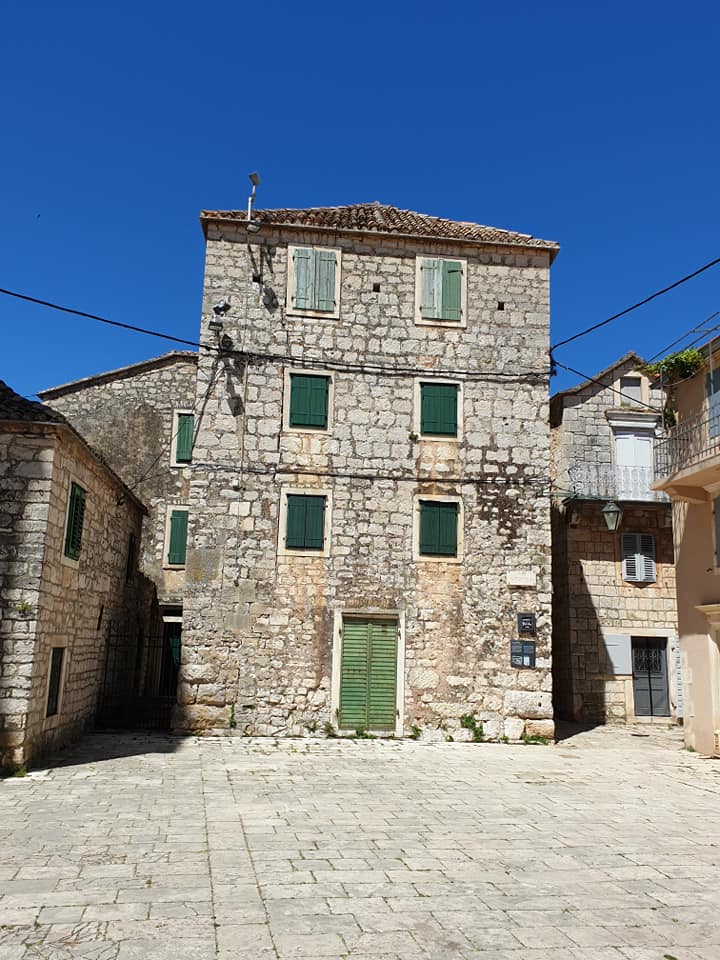
15 years ago, as a real estate agent, I almost sold this building to a foreign buyer who wanted to open a Thai restaurant there. He was put off by the statics of the building after learning how it had been damaged by a bomb in World War II.
And here it was, 15 years later, totally unchanged. Timeless. And a snapshot of the history and stories contained within every stone of this wonderful old town.
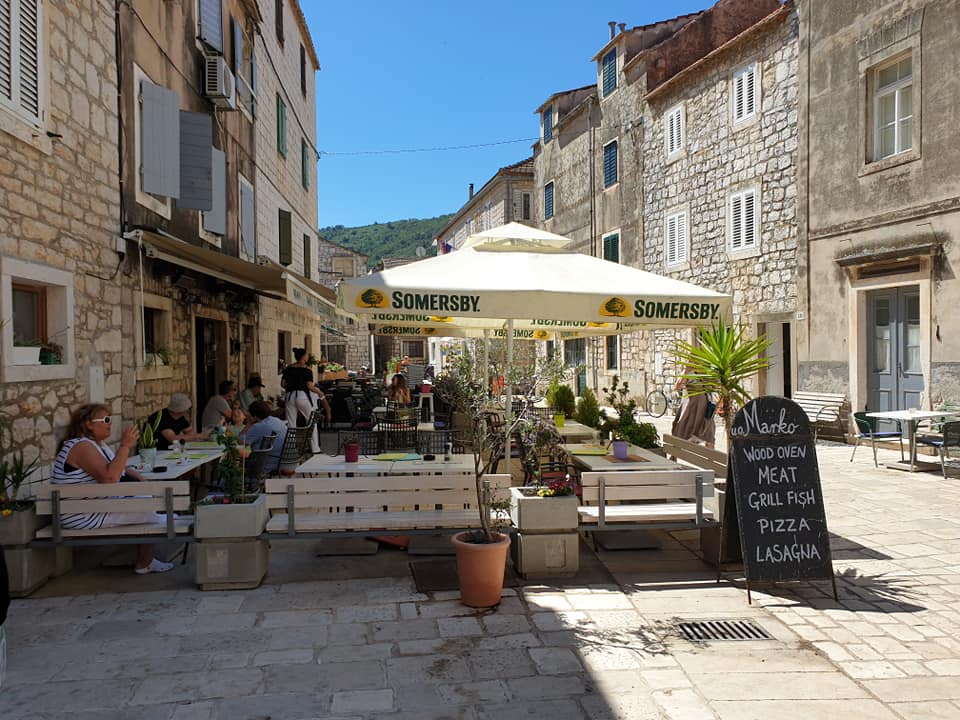
A lot of things had changed, and a lot of things had not. And while there were many new eateries I did not recognise, it was heartening to see the place I used to refer to as the hearbeat of Hvar continuing to thrive. Pizzeria Marko was the main meeting point for lots of the resident expats back in the day - great, affordable food and run by lovely people. And it was great to see that at Marko's - like elsewhere in Stari Grad, some things had changed and nothing had changed.
I visited in late June and had much of the old town to myself, a far cry from the mayhem of the mainland coast which followed.
Want to learn more about Stari Grad? Here are 25 things to know.
For more about the island, check out the Total Croatia Hvar in a Page guide.
New Investments Bringing Better Future to Helios Faros in Stari Grad on Hvar
Valamar Riviera has announced that it has paid 22.8 million kuna for the recapitalisation of the Helios Faros hotel company in Stari Grad on the island of Hvar. The recapitalisation process will also include PBZ Croatia Osiguranje pension fund, creating conditions for Helios Faros to leave the bankruptcy proceedings, reports Večernji List on May 8, 2019.
“In accordance with the decision to increase the share capital, as part of the approved bankruptcy investment and recapitalisation plan, Valamar Riviera has paid 22.8 million kuna to Helios Faros in order to register 2,280,000 shares. At the same time, PBZ Croatia Osiguranje will register 6,840,000 shares for 68.4 million kuna,” the statement reads.
This will increase Helios Faros’ share capital from 5.36 million kuna to 96.56 million kuna. Following the increase in the share capital, Valamar will own 23.61 per cent of Helios Faros’ shares and PBZ Croatia Osiguranje 70.83 per cent.
“The increase in the share capital will create the prerequisites for Helios Faros to leave the bankruptcy proceedings. Through the partnership between Valamar and PBZ CO, a new phase of tourism development in Stari Grad on Hvar will commence,” Valamar said.
Helios Faros is the most important hotel company in Stari Grad. It has been in the bankruptcy proceedings since 2016. In mid-May 2017, Valamar Riviera and PBZ Croatia Osiguranje submitted a joint bid for the investment and recapitalisation of the company.
In July 2017, the Helios Faros creditors’ assembly accepted the joint offer by Valamar Riviera and PBZ Croatia Osiguranje, and it also adopted a decision on the development of a detailed bankruptcy plan that would allow the company to leave the bankruptcy proceedings and continue its operations.
In early November 2018, the creditors’ assembly accepted the bankruptcy plan based on the joint offer by Valamar and PBZ Croatia Osiguranje. The Commercial Court in Split also issued a first-instance ruling confirming the bankruptcy plan for investing and recapitalising of Helios Faros.
Translated from Večernji List.
More Hvar news can be found in the Lifestyle section.
Croatia's Foreign Entrepreneurs: Chloé and Yvan, from Bora Bora to Hvar
Continuing our series on Croatia's foreign entrepreneurs, a look to an extraordinary small business in Stari Grad on Hvar island on February 8, 2018
President Kolinda Among Guests as Stari Grad Turns 2400 in Style
A presidential visit to Stari Grad on Hvar on September 9, 2016, as what is claimed as the oldest town in Croatia turns 2400.


